Brazil is home to a diverse array of birds, with over 1,800 species ranging from colorful parrots and toucans to large predatory birds like eagles and hawks.
With such a vast array of species, Brazil’s birds have become a popular attraction for birdwatchers and wildlife enthusiasts. From the lush rainforests to the bustling coastal cities, the birds of Brazil offer a glimpse into the country’s unique and vibrant natural world.
1. Tanagers
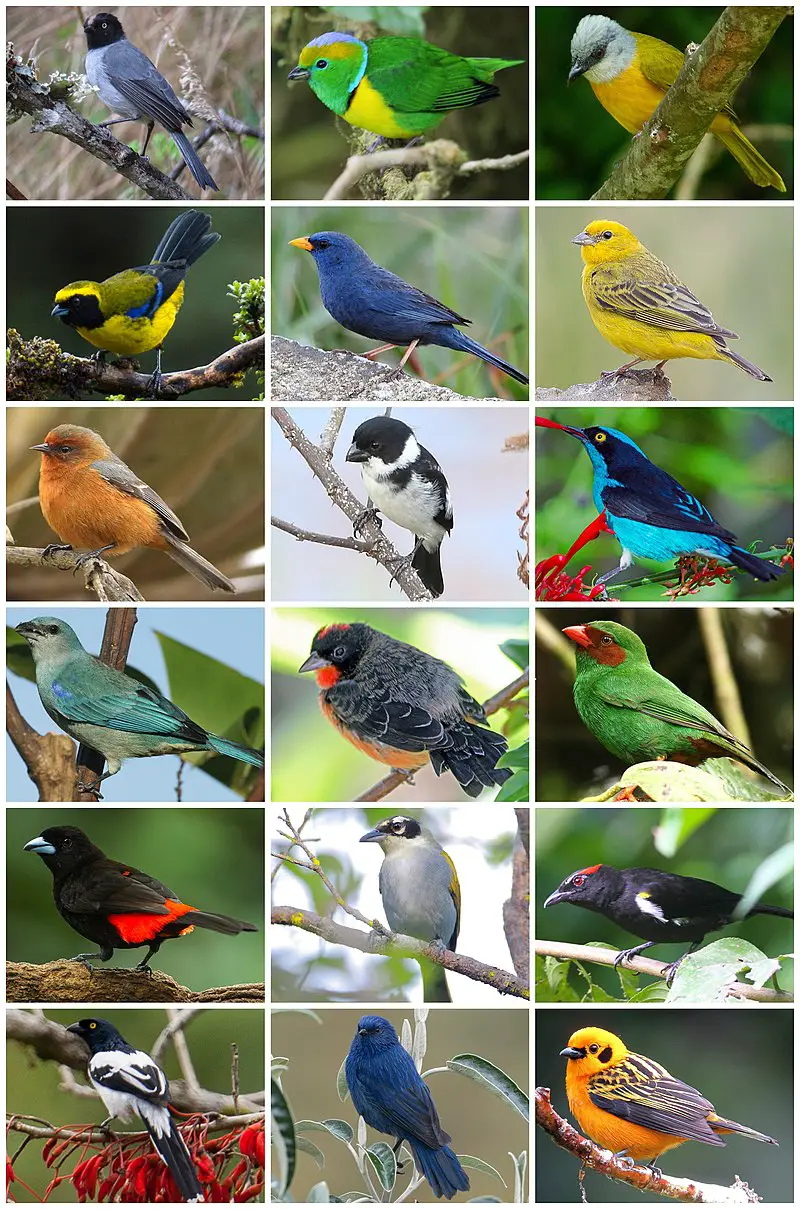
The Tanagers are a beautiful and diverse family of birds native to the Neotropical region. They boast an impressive array of colors, including blues, greens, yellows and reds.
The most common type is the fruit-eating tanager that can be found in tropical forests across Latin America. With nearly 240 species worldwide, they represent almost 4% of all avian species.
These vibrant birds have adapted well to their environment due to their strong bills used for cracking open hard fruits as well as sharp claws for gripping branches while feeding or perching.
As with many other bird families there is natural variation among populations making each one unique in its own way; something that makes them even more special.
Scientific classification:
| Kingdom | Animalia |
| Phylum | Chordata |
| Class | Aves |
| Order | Passeriformes |
| Superfamily | Emberizoidea |
| Family | Thraupidae Cabanis, 1847 |
Also Featured In: Blue Birds You’ll Found around Us, Most Common Lake Birds
2. Toco Toucan
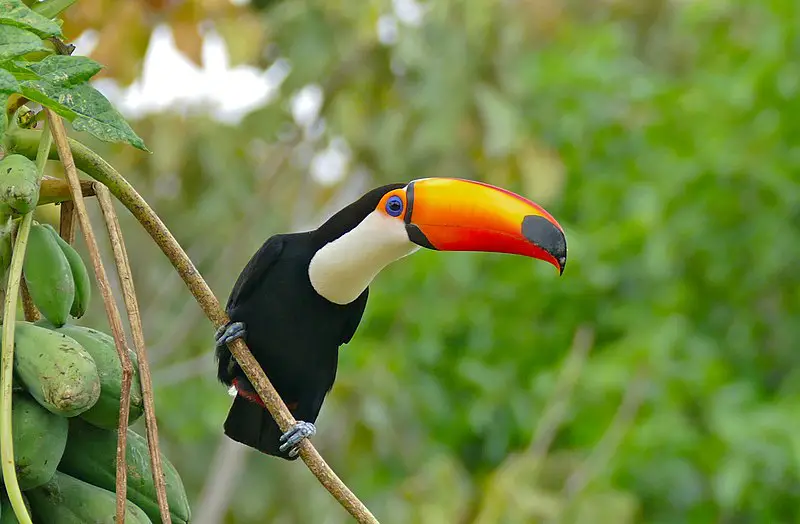
The Toco Toucan is the largest and most recognizable species of toucans, native to semi-open habitats in Central and Eastern South America.
First described by German zoologist Philipp Ludwig Statius Müller in 1776, this colorful bird has two subspecies – Ramphastos toco toco and Ramphastos toco cuvieri – distinguished by their slightly different size, plumage coloration, beak markings and range.
With its large orange bill covered with black spots along the sides of its face contrasting with yellow feathers on top of its head , it’s a very striking animal indeed.
Commonly found in zoos around the world too due tot heir loveable nature they are often kept as pets. They feed mainly on fruit but may also eat insects or small reptiles from time to time.
All in all these birds provide us a wonderful spectacle that we should appreciate for many years ahead.
Scientific classification:
| Kingdom | Animalia |
| Phylum | Chordata |
| Class | Aves |
| Order | Piciformes |
| Family | Ramphastidae |
| Genus | Ramphastos |
| Species | R. toco |
Also Featured In: Birds That Live in the Jungle, Rainforest Birds You Should Know
3. Toucans
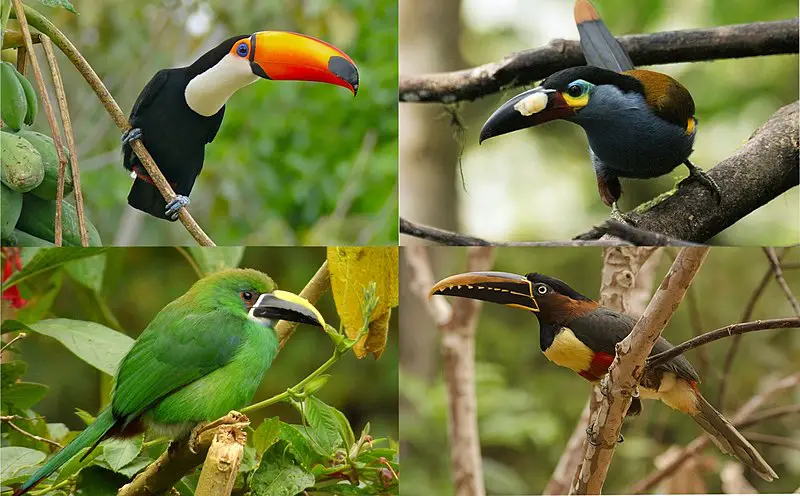
Toucans are members of the Ramphastidae family, which is closely related to American barbets. These birds have brightly-colored feathers and large beaks that come in a variety of colors.
They tend to live high up in trees, where they make their nests with two or four white eggs inside.
Toucans typically feed on fruits and sometimes small insects as well. Some species can even catch larger animals such as reptiles and amphibians for food.
Although toucans like to keep close together when living in groups, during breeding season they become more aggressive towards each other due to competition over resources like nesting sites or food sources.
Scientific classification:
| Kingdom | Animalia |
| Phylum | Chordata |
| Class | Aves |
| Order | Piciformes |
| Infraorder | Ramphastides |
| Family | Ramphastidae Vigors, 1825 |
Also Featured In: Famous Paintings Birds, Most Common Birds in South America Birds
4. Hyacinth Macaw
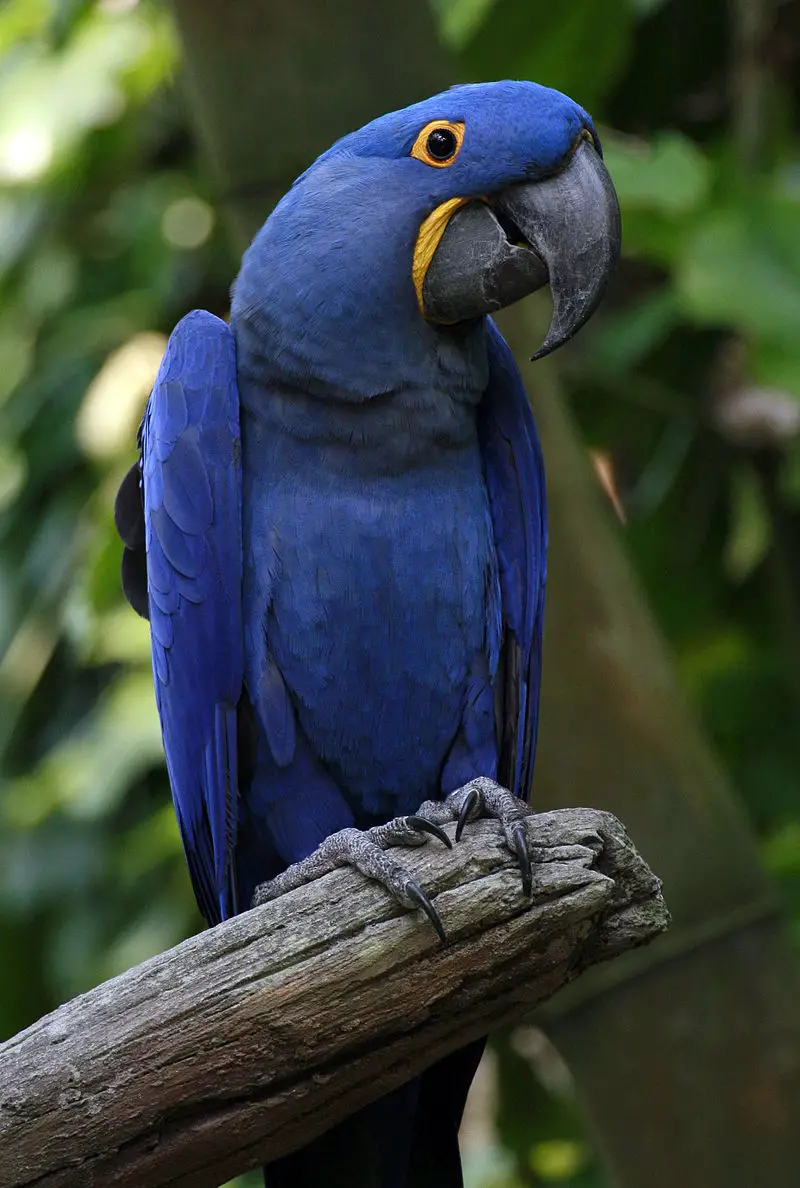
The Hyacinth Macaw is an extraordinary bird, known for its impressive size and vibrant coloration.
It has a length of around one meter, making it the longest parrot species in existence as well as the largest flying parrot species; even larger than 3.5 kg flightless Kākāpō from New Zealand.
Its striking blue plumage with yellow at its wingtips gives this majestic bird an eye-catching appearance that’s sure to turn heads wherever it goes.
Native to central and eastern South America, these birds are highly intelligent creatures who form strong bonds with their owners when kept in captivity.
They make great companions if given proper care and attention which includes providing them with plenty of space for exercise and enrichment activities such as playtime out of the cage on occasion or teaching them tricks using positive reinforcement methods like verbal praise or food rewards.
Scientific classification:
| Kingdom | Animalia |
| Phylum | Chordata |
| Class | Aves |
| Order | Psittaciformes |
| Family | Psittacidae |
| Genus | Anodorhynchus |
| Species | A. hyacinthinus |
Also Featured In: Birds You’ll Find in Zoo, Common Latin America Birds
5. Scarlet Macaw
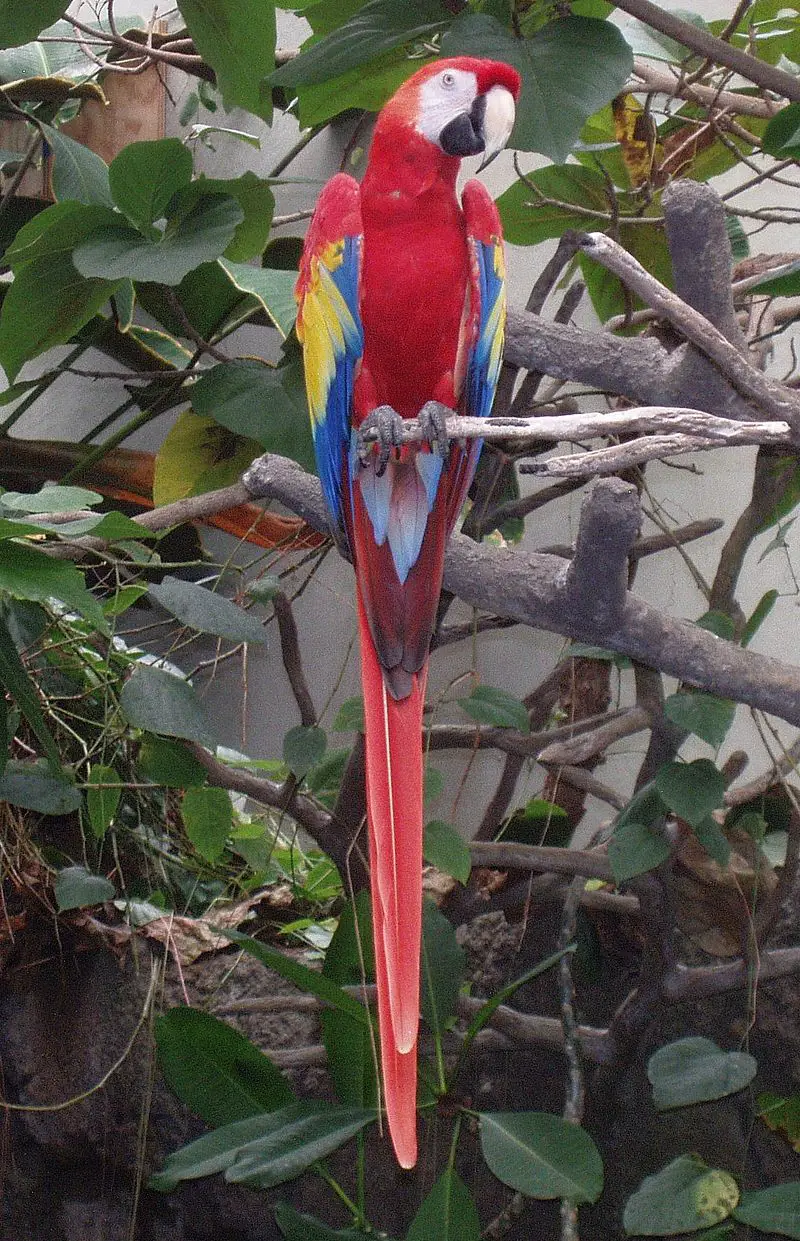
The Scarlet Macaw is a vibrant and beautiful bird found in Central and South America. Its striking red, yellow, and blue feathers make it stand out among other parrots.
It inhabits humid evergreen forests of the Neotropics from Mexico to Peru, Ecuador, Colombia, Bolivia Venezuela Brazil up to an altitude of 1000m (3300ft).
These birds have strong beaks which they use for breaking open hard nuts or seeds that would otherwise remain inaccessible.
They also form social bonds with their mates by grooming eachothers’ feathers and engaging in playful activities such as chasing one another around tree trunks.
Despite its vivid colors the Scarlet Macaw remains vulnerable due to habitat loss caused by deforestation so conservation efforts are essential if this amazing species is going to survive for future generations.
Scientific classification:
| Kingdom | Animalia |
| Phylum | Chordata |
| Class | Aves |
| Order | Psittaciformes |
| Family | Psittacidae |
| Genus | Ara |
| Species | A. macao |
Also Featured In: Common Tropical Rainforest Birds, Spiritual Birds
6. Rufous-Bellied Thrush
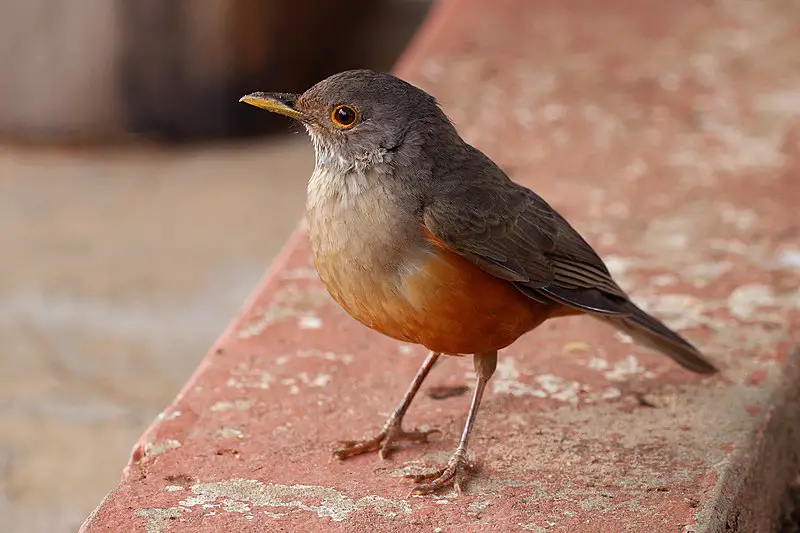
The Rufous-bellied Thrush is a songbird of the Turdidae family, commonly found in Brazil, Bolivia, Paraguay, Uruguay and parts of Argentina. It has brownish orange feathers on its back and throat while it’s underside is bright yellow.
This species likes to inhabit open woodland areas such as lowland evergreen forests or mangroves where they feed on insects like beetles, ants and caterpillars.
They are also known for their beautiful songs which consist of whistles with staccato notes at the end that make them easily identifiable amongst other thrushes.
The populations have remained relatively stable over time but due to deforestation there has been some decline in numbers so conservation efforts need to be implemented if we want this species around for many more years to come.
Scientific classification:
| Kingdom | Animalia |
| Phylum | Chordata |
| Class | Aves |
| Order | Passeriformes |
| Family | Turdidae |
| Genus | Turdus |
| Species | T. rufiventris |
7. Greater Rhea
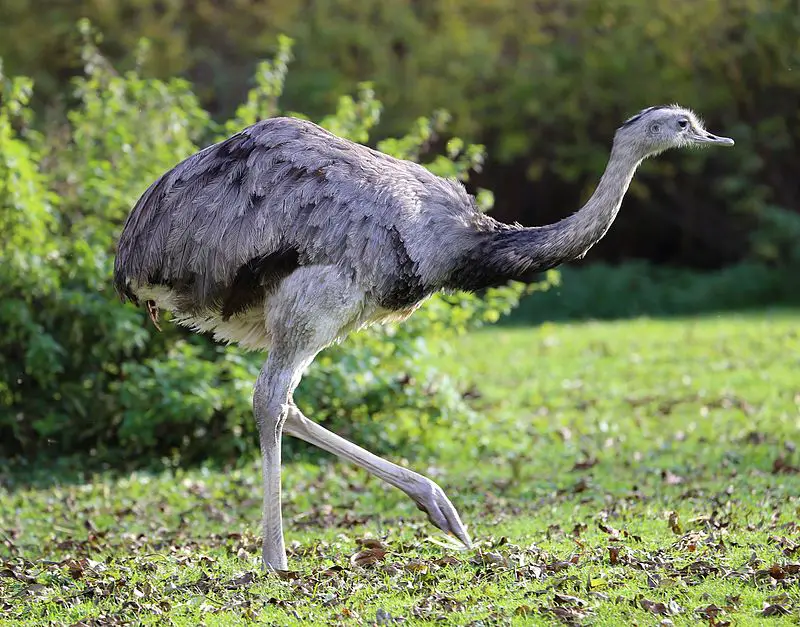
The Greater Rhea is a flightless bird native to eastern South America. It has many different names, including the Grey, Common or American Rhea, Ema (Portuguese) and Ñandú (Guaraní and Spanish).
This species of rhea lives in Brazil, Bolivia, Argentina Paraguay and Uruguay. It inhabits open areas such as grasslands with scattered shrubs and trees.
They are mostly active during the day when they feed on plants like grasses as well as small animals like insects.
The greater rheas can also be seen running away from potential predators like foxes or coyotes at high speeds up to 70 km/h.
These majestic birds have an impressive wingspan that reaches 6 feet across – making them one of the largest flying birds in their region.
Scientific classification:
| Kingdom | Animalia |
| Phylum | Chordata |
| Class | Aves |
| Infraclass | Palaeognathae |
| Order | Rheiformes |
| Family | Rheidae |
| Genus | Rhea |
| Species | R. americana |
8. Wattled Jacana
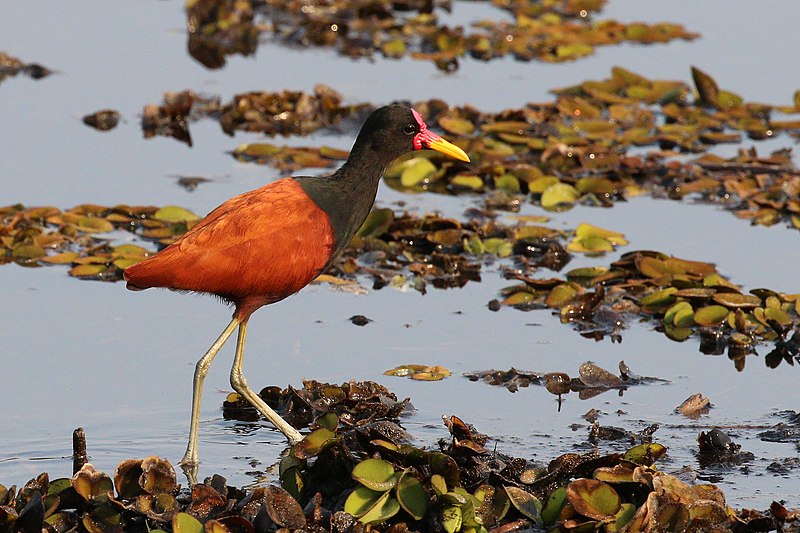
The Wattled Jacana is a stunning bird from central and south America. It has long legs, a black head with yellow wattles at each side, and striking chestnut brown wings.
This wader builds its nest on the surface of ponds or lakes using floating vegetation such as lily pads to anchor it in place – usually with four eggs that are darkly marked.
The male takes primary responsibility for incubation of these eggs between his wings, while the female will take care of her chicks once they hatch out.
These birds feed mainly on aquatic insects but also small fish and amphibians if available.
Overall this species is an interesting and attractive addition to any wetland habitat.
Scientific classification:
| Kingdom | Animalia |
| Phylum | Chordata |
| Class | Aves |
| Order | Charadriiformes |
| Family | Jacanidae |
| Genus | Jacana |
| Species | J. jacana |
9. Cuculiformes
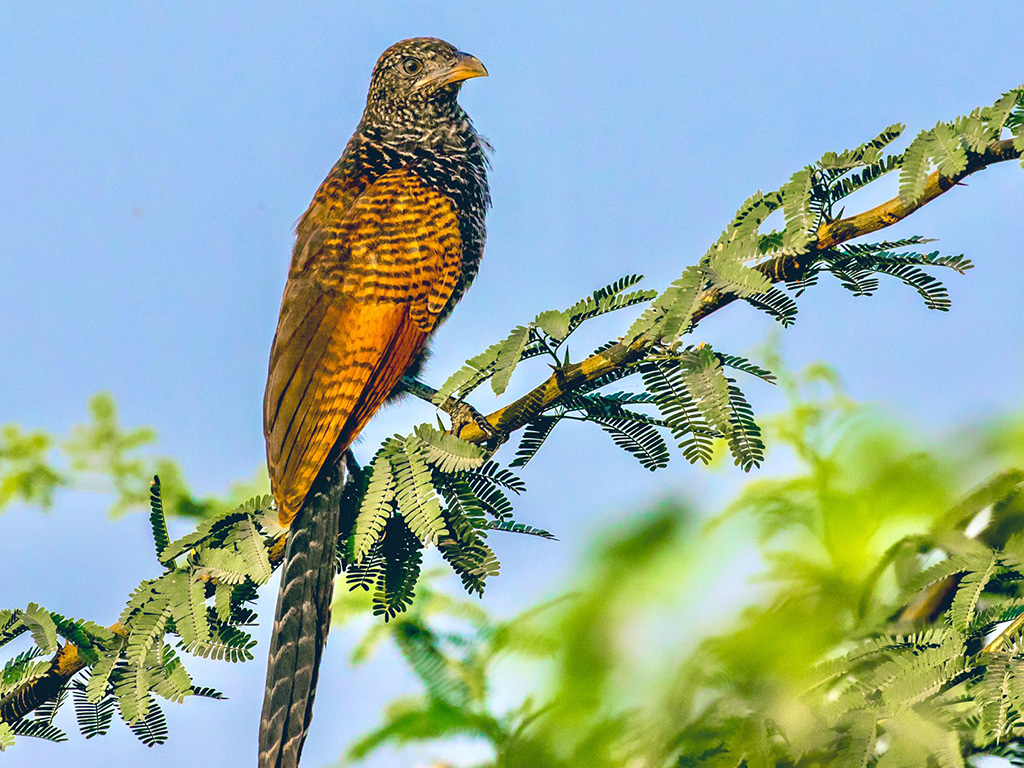
Cuculiformes are a large order of birds that includes cuckoos, roadrunners and turacos. These birds have long wings, short tails and strong legs which help them to fly from tree-to-tree in search for food.
They also use their feet to grab items such as insects or fruits while hopping around branches. Cuculiformes feed on invertebrates like caterpillars , spiders, moths & lizards but some species will eat fruit & seeds too .
Their nests usually consist of twigs lined with soft material such as feathers or moss depending on the specie they belong to. The eggs laid by cucilforme females range between white to yellowish brown colouration speckled with reddish spots.
Most Cucilformes exhibit monogamous behaviour where both parents participate in taking care of the young ones until they can fly away independently
10. Hoatzin
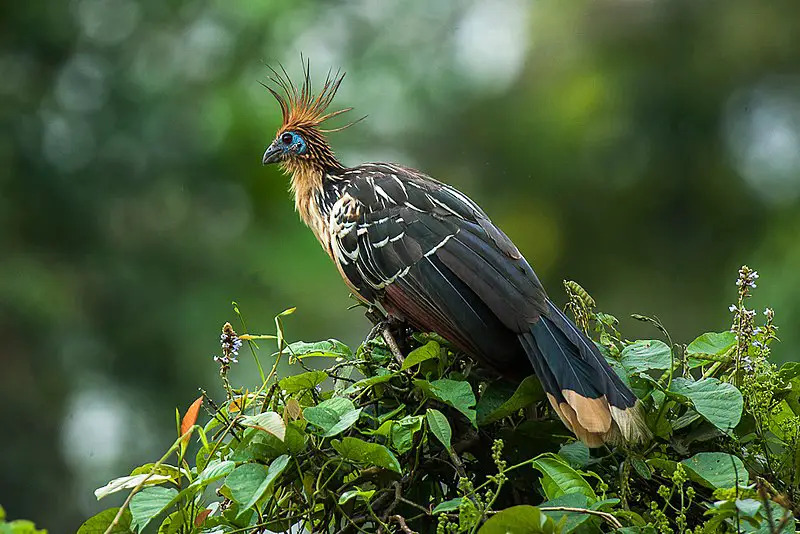
The Hoatzin bird is a tropical species found in the Amazon and Orinoco river basins of South America. It inhabits swamps, riparian forests and mangroves.
This unique bird has chicks that have claws on two of their wing digits which make it the only member in its order – Opisthocomiformes.
Its most distinctive feature is an odour produced from its digestive system which smells like cow manure.
The adults are brownish-grey with blue facial skin, red eyes, pointed crest feathers and black primaries.
They feed mainly on leaves but also eat flowers, fruits or buds when available during different seasons.
They can be heard making loud calls resembling caws at night time as well as repeated whistles throughout the day to keep contact between family members within flocks.
Scientific classification:
| Kingdom | Animalia |
| Phylum | Chordata |
| Class | Aves |
| Order | Opisthocomiformes |
| Family | Opisthocomidae |
| Genus | Opisthocomus Illiger, 1811 |
| Species | O. hoazin |
Also Featured In: Birds that Live in Guyana,
11. Shorebirds
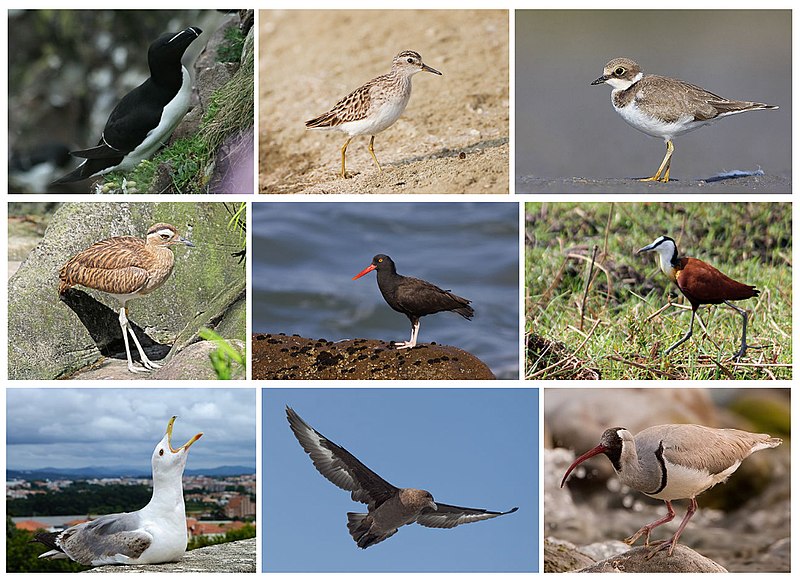
Shorebirds, a diverse group of birds in the Charadriiformes order, are found near water on every continent except Antarctica.
These small to medium-sized birds feed mainly on invertebrates and other small animals but can also be pelagic seabirds or inhabit deserts.
Shorebirds use their long bills to probe mudflats for food like worms and mollusks while some species plunge into the ocean’s depths in search of crustaceans such as crabs and shrimp.
They have strong legs equipped with webbed feet which allow them to move quickly when searching for prey across wetlands, sandbars, beaches and swamps.
Their feathers make them well adapted to life by land or sea due to its hydrophobic nature which helps reduce drag during swimming or flying through windy conditions making it easier for shorebirds survive tough environments around the world.
Scientific classification:
| Kingdom | Animalia |
| Phylum | Chordata |
| Class | Aves |
| Infraclass | Neognathae |
| Clade | Neoaves |
| Clade | Gruimorphae |
| Order | Charadriiformes Huxley, 1867 |
Also Featured In: Turkey Birds You Should Know, Water Birds Live around Us
12. Cracidae
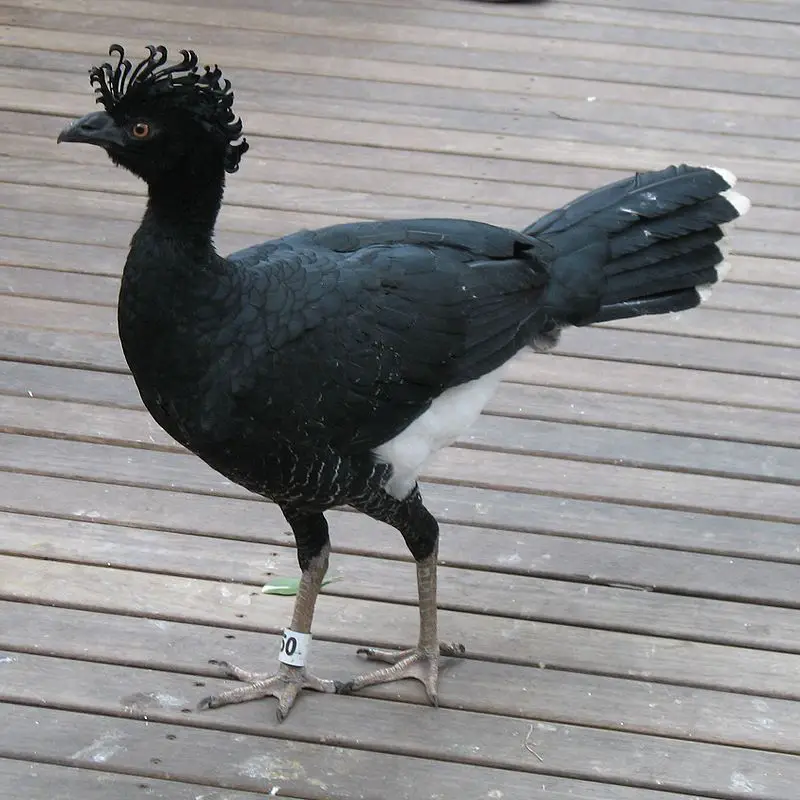
Cracidae is a family of tropical and subtropical birds found in Central and South America. The most well-known species are chachalacas, guans, and curassows.
These birds can also be seen in southern parts of Texas in the United States as well as Trinidad & Tobago islands. They typically have long tails with a rounded tip that helps them keep balance during flight or when perched on branches.
Moreover, they usually have short wings so they don’t fly very far but rather hop from tree to tree within their habitat range.
Cracids use their sharp claws for climbing trees while searching for food such as fruits, nuts insects etc.. Some members of this bird family are considered endangered due to hunting pressure by humans or loss of habitats caused by deforestation activities among others factors .
Scientific classification:
| Kingdom | Animalia |
| Phylum | Chordata |
| Class | Aves |
| Order | Galliformes |
| Family | Cracidae Rafinesque, 1815 |
13. Southern Lapwing
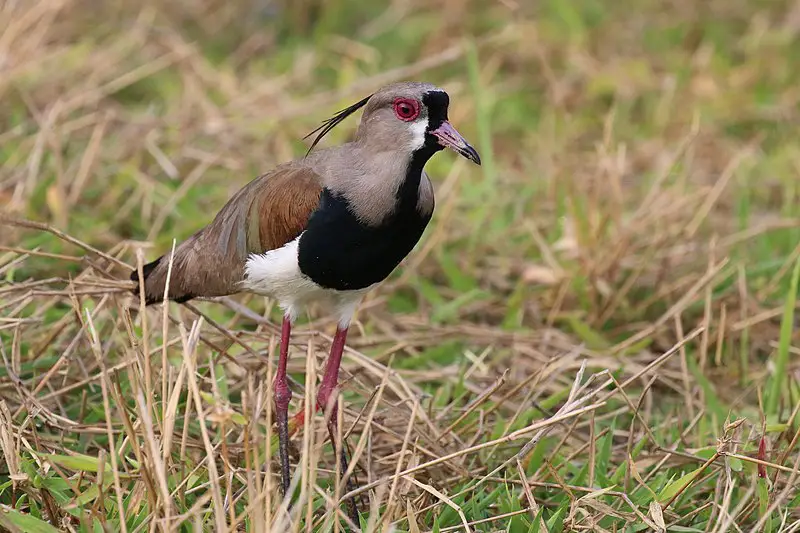
The Southern lapwing, also known as quero-quero in Brazil or tero in Argentina and Uruguay, is a wader that can be found throughout South America.
It inhabits open areas like grasslands and fields but avoids heavily forested regions such as the Amazon basin.
This bird has an unmistakable appearance with its black-and-white plumage contrasting against its bright yellow bill and legs.
The male’s feathers are more vibrant than those of the female, making them easily distinguishable from each other.
They feed on worms and insects which they search for by probing their long bills into soft ground while walking around looking for food.
Lapwings are highly territorial birds who will protect their nests fiercely from any potential predators or intruders.
Scientific classification:
| Kingdom | Animalia |
| Phylum | Chordata |
| Class | Aves |
| Order | Charadriiformes |
| Family | Charadriidae |
| Genus | Vanellus |
| Species | V. chilensis |
Also Featured In: Patagonia Birds You Should Know,
14. Screamer
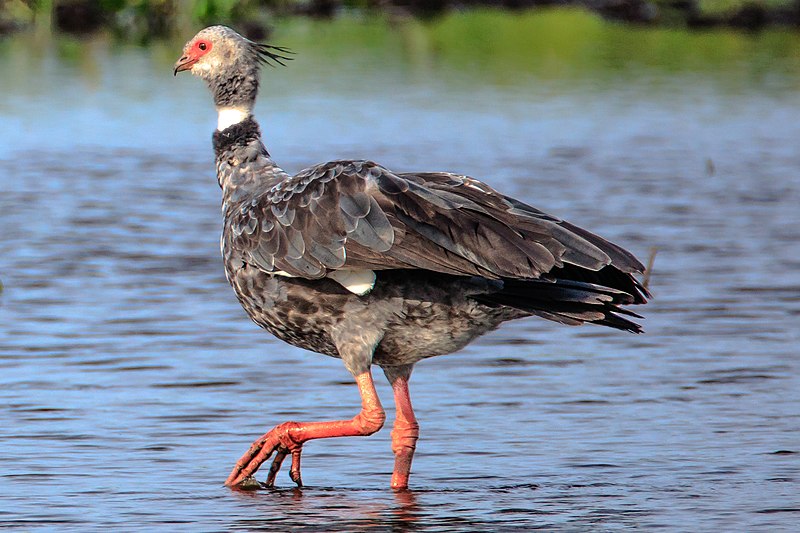
Screamers are a unique and interesting family of birds found exclusively in South America. They consist of three species, the Horned Screamer, the Northern Screamer and the Southern Screamer.
Although they have bills similar to galliformes, they are more closely related to ducks from Anatidae family. Their uniqueness lies in absence of uncinate processes on their ribs which is rare among living birds.
These bold-coloured creatures can be seen inhabiting grasslands or wetlands mostly near water bodies like lakes or rivers where food sources such as fish, amphibians and aquatic plants are abundant for them to feed on.
Despite having no song-making ability these beautifully coloured avian beings make loud honking sounds that resemble screams hence giving them their name “screamers”.
Scientific classification:
| Kingdom | Animalia |
| Phylum | Chordata |
| Class | Aves |
| Order | Anseriformes |
| Suborder | Anhimae Wetmore & Miller 1926 |
| Family | Anhimidae Stejneger, 1885 |
15. Neotropic Cormorant
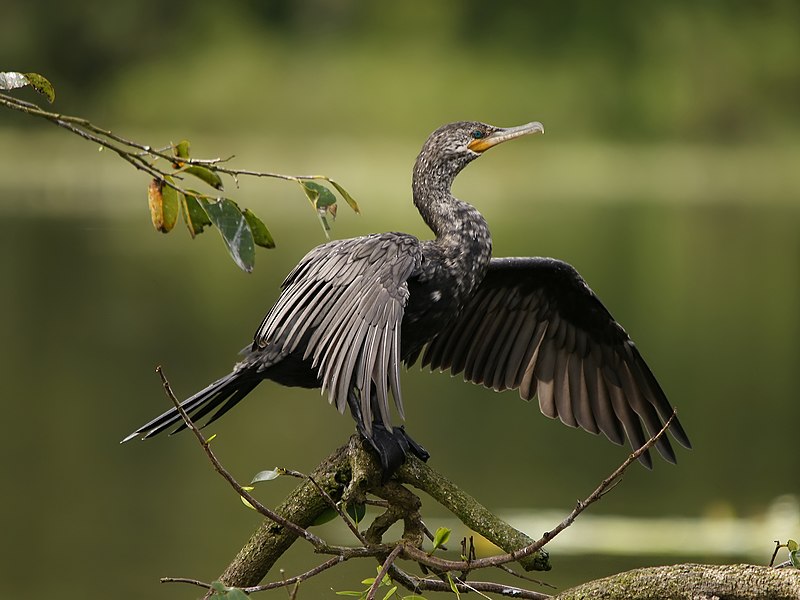
The Neotropic Cormorant, also known as the Olivaceous Cormorant, is a medium-sized bird found in tropical and subtropical regions of Central America, South America and the United States.
It can be identified by its black body with bright yellow facial skin on both sides of its large bill. The tail feathers are short and squared off at the tip.
This species breeds mainly on coasts but will sometimes nest inland near rivers or lakes during certain parts of their life cycle.
They feed mostly on small fish caught while diving underwater but can also eat crustaceans, amphibians and insects.
These birds roost in trees at night to keep safe from predators like foxes which prey upon them when they sleep close to water sources during daylight hours.
Scientific classification:
| Kingdom | Animalia |
| Phylum | Chordata |
| Class | Aves |
| Order | Suliformes |
| Family | Phalacrocoracidae |
| Genus | Nannopterum |
| Species | N. brasilianum |
Also Featured In: Puerto Vallarta Birds You Should Know, Common Birds of Houston
16. Anhinga
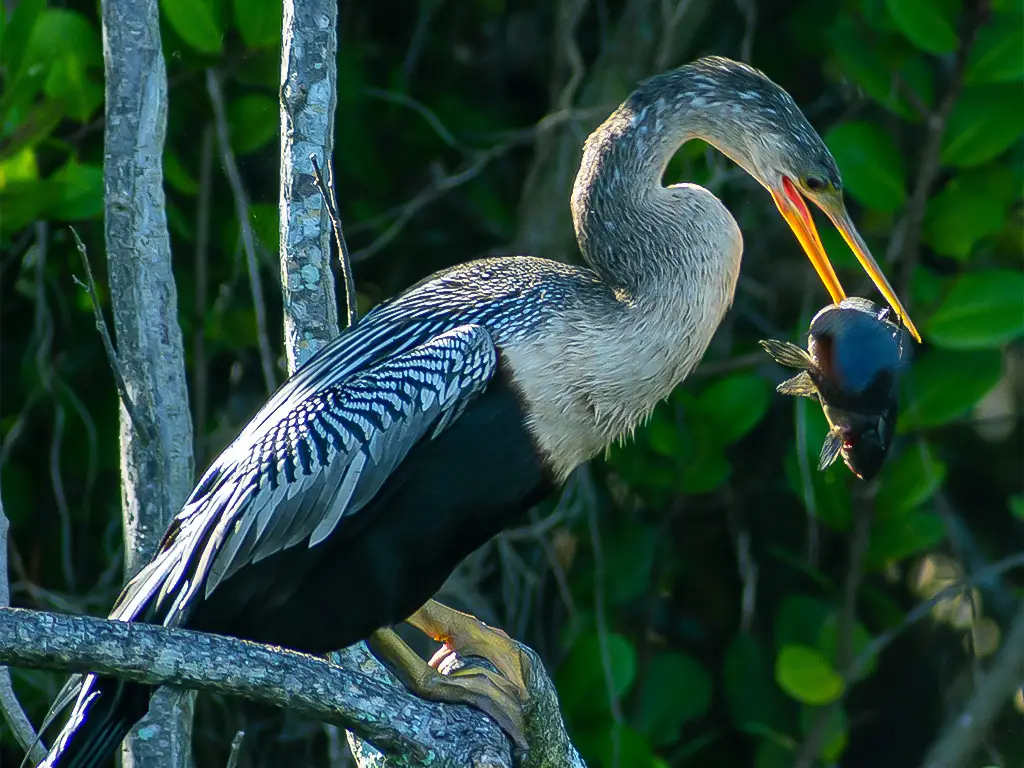
Cuculiformes are a large order of birds that includes cuckoos, roadrunners and turacos. These birds have long wings, short tails and strong legs which help them to fly from tree-to-tree in search for food.
They also use their feet to grab items such as insects or fruits while hopping around branches. Cuculiformes feed on invertebrates like caterpillars , spiders, moths & lizards but some species will eat fruit & seeds too .
Their nests usually consist of twigs lined with soft material such as feathers or moss depending on the specie they belong to. The eggs laid by cucilforme females range between white to yellowish brown colouration speckled with reddish spots.
Most Cucilformes exhibit monogamous behaviour where both parents participate in taking care of the young ones until they can fly away independently
17. Red-Billed Tropicbird
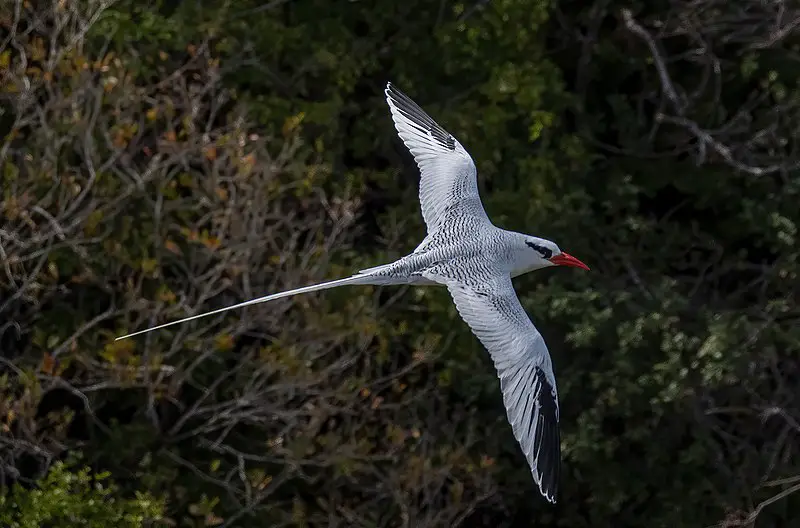
The Red-billed Tropicbird is a beautiful seabird found in tropical oceans. It has mainly white plumage, with black markings on its wings and back, along with a black mask and red bill.
These birds have distinctive long tail streamers that are twice their body length which they use to help them soar above the ocean surface while searching for food.
They primarily feed off squid, fish and crustaceans that inhabit coral reefs or deep sea areas where they can dive up to 30 meters below the water’s surface.
The Red-billed Tropicbird was once thought of as an omen of bad luck but now it serves as a reminder of how delicate our marine ecosystems are when faced with human activity such as overfishing.
Scientific classification:
| Kingdom | Animalia |
| Phylum | Chordata |
| Class | Aves |
| Order | Phaethontiformes |
| Family | Phaethontidae |
| Genus | Phaethon |
| Species | P. aethereus |
18. Manakin
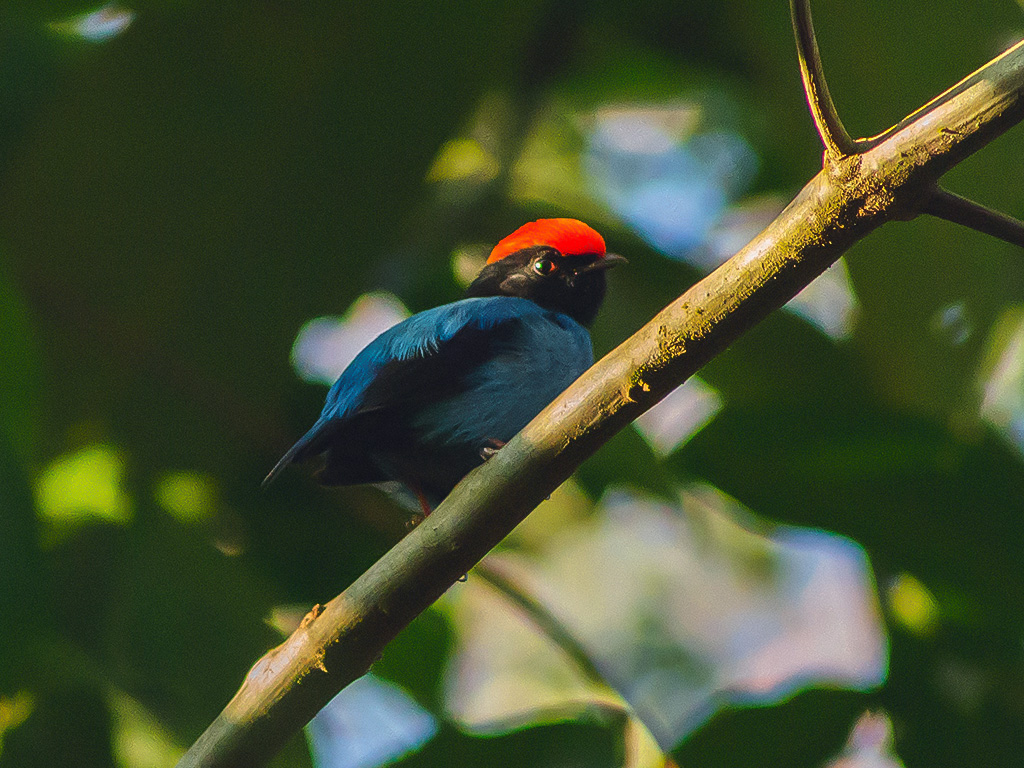
Manakins are a family of small, suboscine passerine birds found in the American tropics. They measure between 7 to 15 cm and weigh between 8-30 gm.
Some 54 species have been identified so far, all belonging to genus Tyranneutes which is characterized by their bright feather colors and unique courtship behaviors like hopping or fluttering around female manakin.
The name ‘manakin’ has its origin from Middle Dutch word ‘mannekijn’ meaning little man – aptly describing these vibrant feathered creatures.
Although they inhabit different habitats including forests, woodlands etc., some species remain threatened due to habitat destruction and fragmentation.
Scientific classification:
| Kingdom | Animalia |
| Phylum | Chordata |
| Class | Aves |
| Order | Passeriformes |
| Parvorder | Tyrannida |
| Family | Pipridae Rafinesque, 1815 |
19. Burrowing Owl
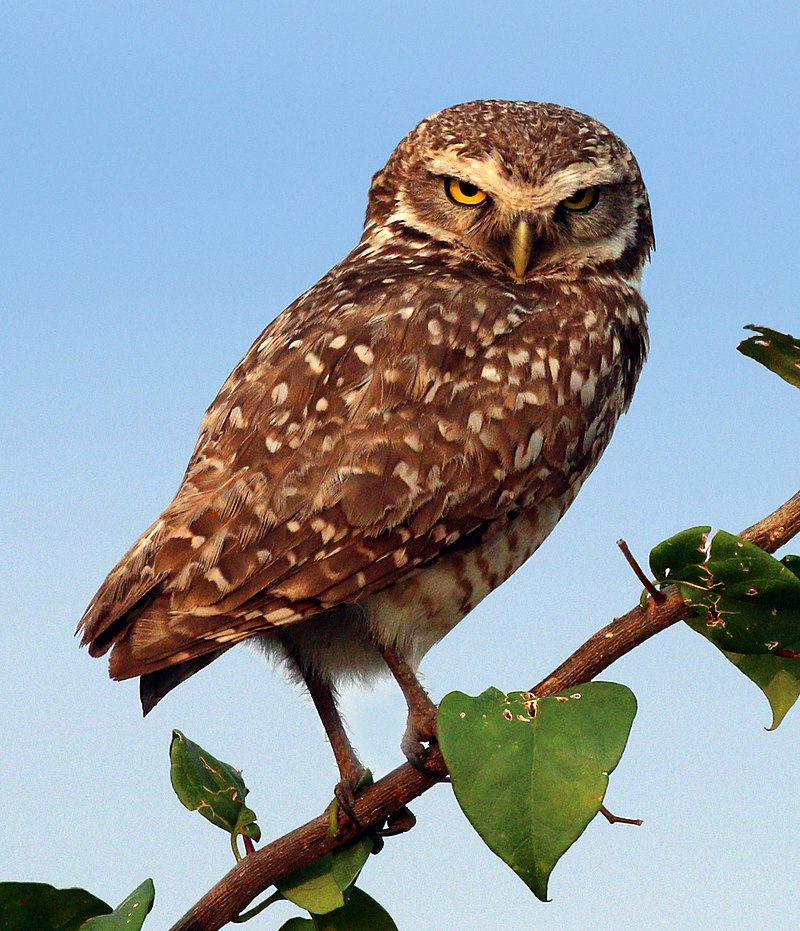
The Burrowing Owl is a small, long-legged owl found in open landscapes throughout North and South America. They are typically seen in grasslands, rangelands, agricultural areas or deserts with low vegetation.
Unlike most owls they nest and roost underground by taking over burrows made by other animals such as prairie dogs.
Their diet consists of insects, rodents and sometimes lizards or frogs that they hunt during the night time hours when their eyesight is sharpest.
This species faces threats due to habitat loss caused by human development but conservation efforts have been successful at reversing some of this damage allowing for populations to remain stable into the future despite these pressures.
Scientific classification:
| Kingdom | Animalia |
| Phylum | Chordata |
| Class | Aves |
| Order | Strigiformes |
| Family | Strigidae |
| Genus | Athene |
| Species | A. cunicularia |
Also Featured In: Birds that Live in the Deserts, Common Southern Californian Birds
20. Yellow-Faced Parrot
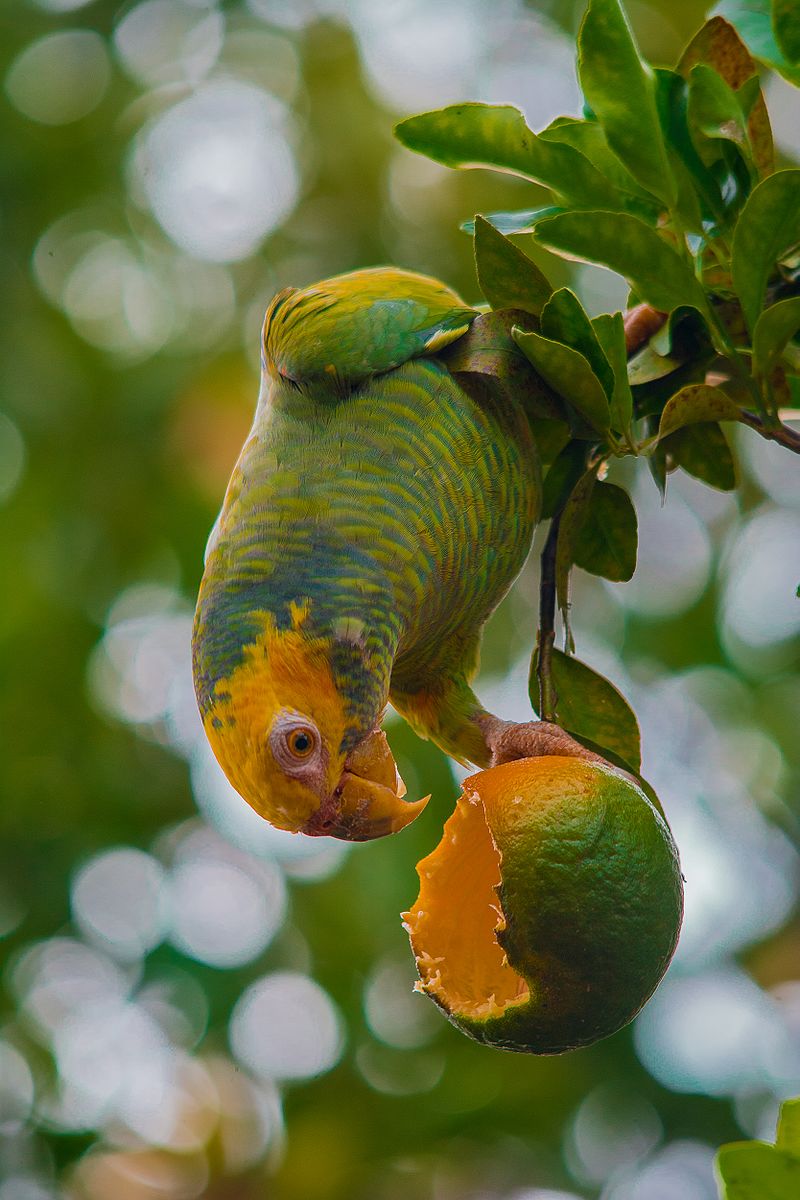
The Yellow-faced Parrot is a stunning bird native to the Neotropics. It has a predominantly green body with yellow plumage on its head, giving it an unmistakable look.
This semi-nomadic species can be found in Brazil and parts of Bolivia, where it inhabits the cerrado savannah region. As well as being beautiful to behold, these birds are highly intelligent and sociable creatures that can even learn human speech.
Despite their beauty they remain largely unknown due to their remote habitat; however conservation efforts may help prevent them from disappearing altogether.
Scientific classification:
| Kingdom | Animalia |
| Phylum | Chordata |
| Class | Aves |
| Order | Psittaciformes |
| Family | Psittacidae |
| Genus | Alipiopsitta Caparroz and Pacheco, 2006 |
| Species | A. xanthops |
21. Southern Screamer
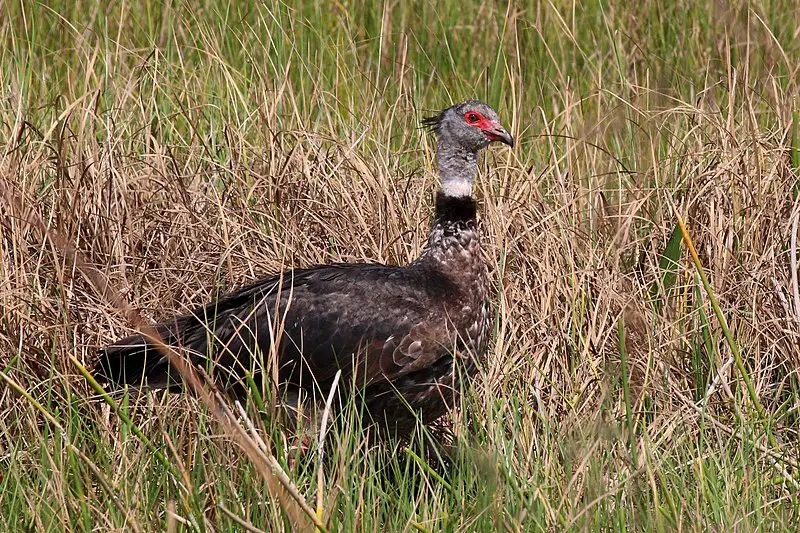
The Southern screamer is a species of bird found in South America, belonging to the family Anhimidae. It has an unmistakable call that sounds like “screaming”, earning it its name.
The plumage is primarily white and black with bright yellow eyes, legs and bill. They are large birds measuring up to 75 centimeters long from beak to tail-tip.
These birds inhabit wetlands such as swamps and marshes where they feed on seeds, grains, aquatic plants and small invertebrates which they find while wading or diving into shallow water bodies.
Despite their loud calls when alarmed or disturbed these birds have adapted well to human presence by living around agricultural areas near humans settlements where food sources are plentiful making them quite common within their range.
Scientific classification:
| Kingdom | Animalia |
| Phylum | Chordata |
| Class | Aves |
| Order | Anseriformes |
| Family | Anhimidae |
| Genus | Chauna |
| Species | C. torquata |
22. Guira Cuckoo
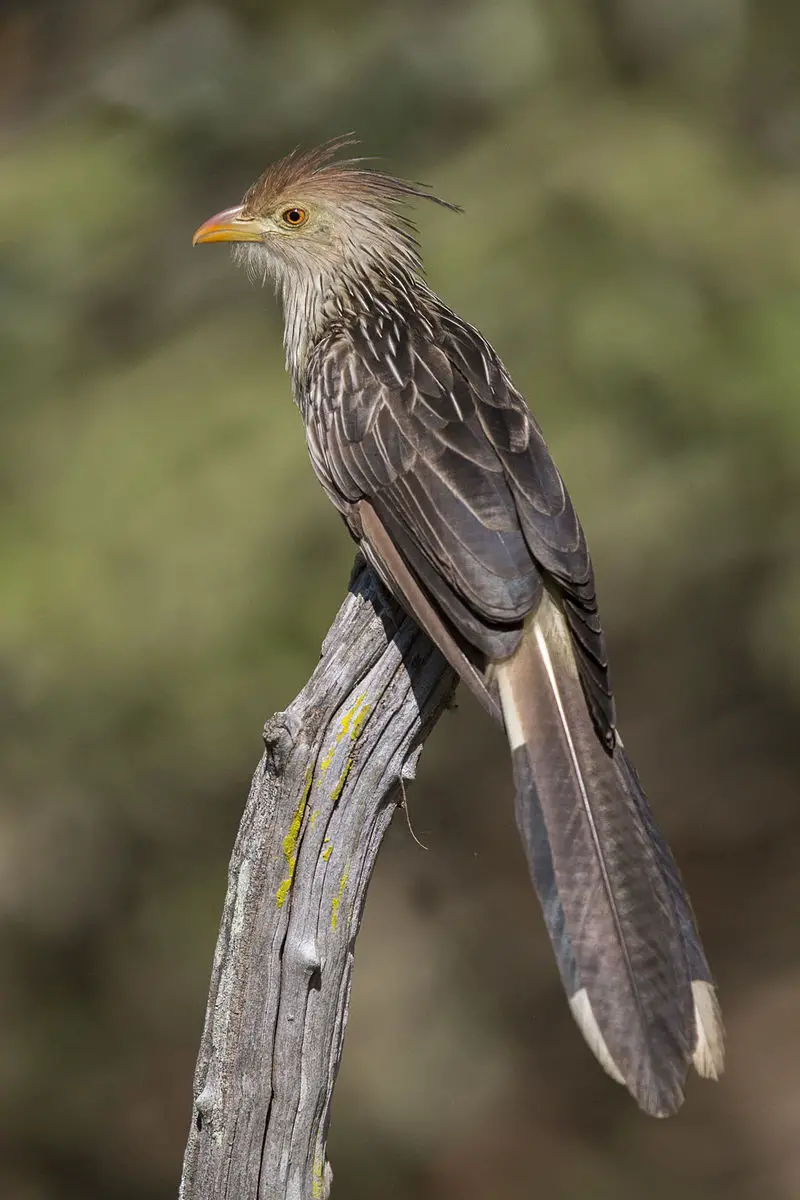
The guira cuckoo is a large, gregarious bird found in open and semi-open habitats of northern South America. It has a distinctive call that can be heard throughout the day, earning it its name due to its resemblance to the sound of a guiro or güiro instrument.
The species was first described by German naturalist Georg Marcgrave in 1648 as part of his Historia Naturalis Brasiliae.
They live mainly on insects but may also take small vertebrates such as frogs or lizards if available. Their nests are built high up in trees with twigs, grasses, leaves and feathers for lining.
These birds are social animals often seen congregating around water sources during hot weather periods when food becomes scarce.
Scientific classification:
| Kingdom | Animalia |
| Phylum | Chordata |
| Class | Aves |
| Order | Cuculiformes |
| Family | Cuculidae |
| Genus | Guira Lesson, 1830 |
| Species | G. guira |
23. Petrels
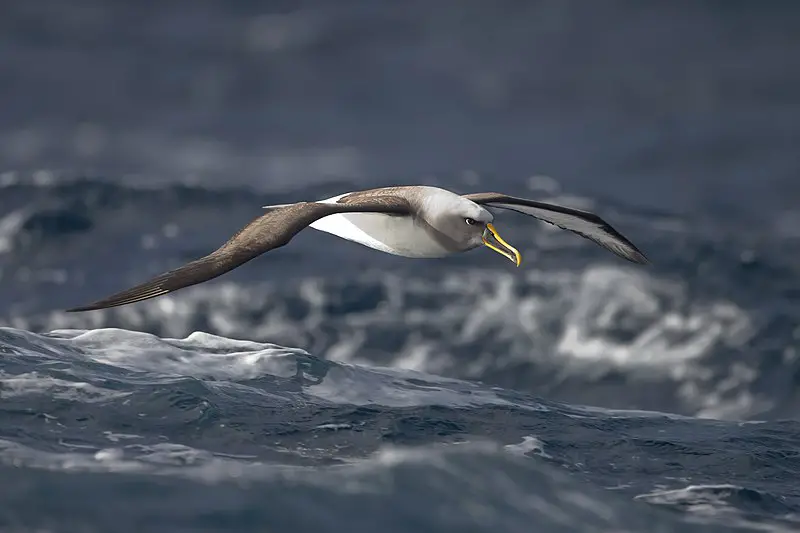
Petrels are seabirds that belong to the Procellariiformes order. They come from four families: albatrosses, petrels and shearwaters, as well as two storm petrel families.
Commonly referred to collectively as ‘petrels’, these birds have a long history of being called Tubinares or tubenoses – referring to their distinctive beaks which feature small tubes on either side for them to detect food in dark seawater.
Petrels mainly consume fish, squid and other small marine creatures, but they also feed off carrion when needed.
These waterbirds can fly great distances over open oceans in search of food with no land insight.
Scientific classification:
| Kingdom | Animalia |
| Phylum | Chordata |
| Class | Aves |
| Clade | Austrodyptornithes |
| Order | Procellariiformes Fürbringer, 1888 |
Also Featured In: Birds You’ll Find in the Sea, Birds that Live in the Ocean
24. Amazon Kingfisher
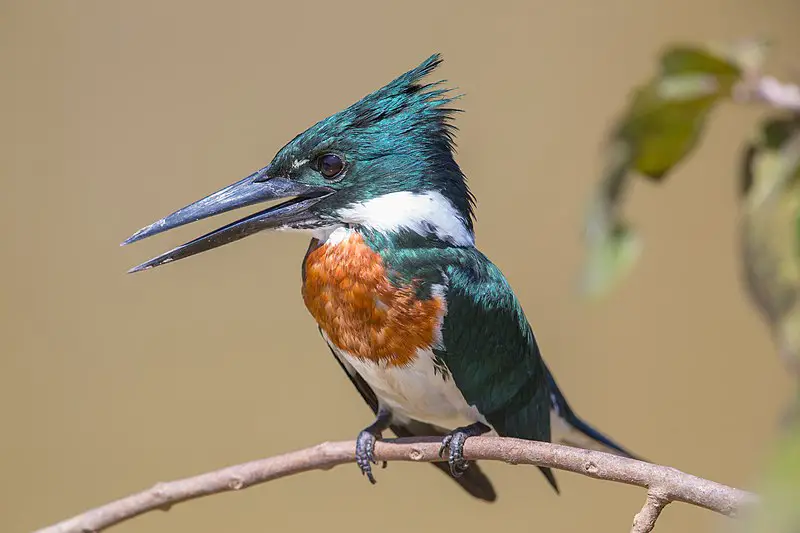
The Amazon Kingfisher is a stunning species of water kingfisher found in the lowlands of Central and South America.
It has an aqua-green head, chestnut wings with white markings, blue back and tail and yellow feet.
Its dramatic plumage makes it one of the most attractive birds in its region.
The Amazon Kingfisher can be seen perching on branches or flying close to slow moving rivers while they search for food such as fish, frogs, lizards or insects which they catch by diving into the water from above.
Despite their colorful appearance these bird are incredibly shy so it’s difficult to get too close without scaring them away.
Scientific classification:
| Kingdom | Animalia |
| Phylum | Chordata |
| Class | Aves |
| Order | Coraciiformes |
| Family | Alcedinidae |
| Subfamily | Cerylinae |
| Genus | Chloroceryle |
| Species | C. amazona |
Also Featured In: Birds that You’ll Find in Chiapas, Most Common Oaxaca Birds
25. Jandaya Parakeet
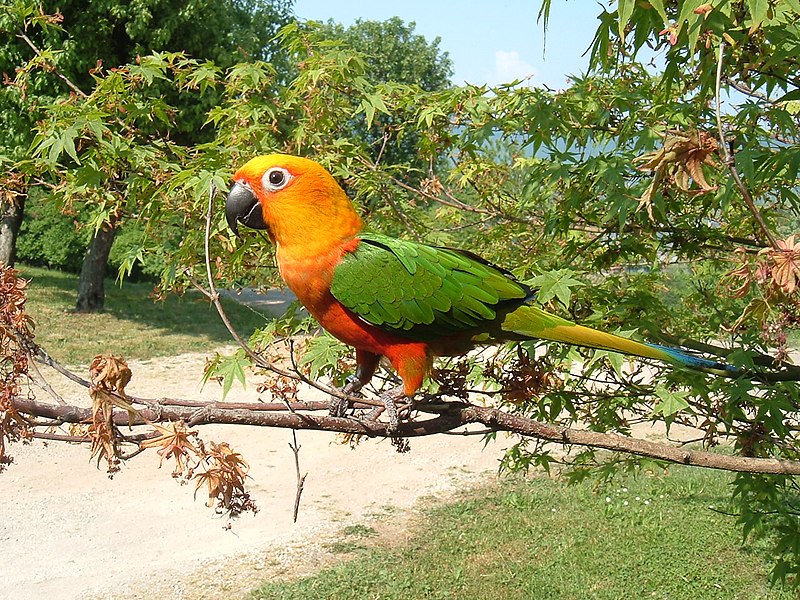
The Jandaya Parakeet is a vibrant and beautiful bird native to northeastern Brazil. It has green wings and tail, reddish-orange body, yellow head and neck, orange cheeks, and black bill.
This small Neotropical parrot inhabits wooded habitats across its wide range in the region. The species belongs to the Aratinga solstitialis complex of parakeets that are closely related to sun parakeets; some experts consider it as a subspecies of this larger group.
They have an outgoing personality with bright colors making them popular among pet owners too. These birds can be socialized easily if raised from young age and make great companions for life together with plenty of love & care from their human family members.
Scientific classification:
| Kingdom | Animalia |
| Phylum | Chordata |
| Class | Aves |
| Order | Psittaciformes |
| Family | Psittacidae |
| Genus | Aratinga |
| Species | A. jandaya |
26. Jacanas
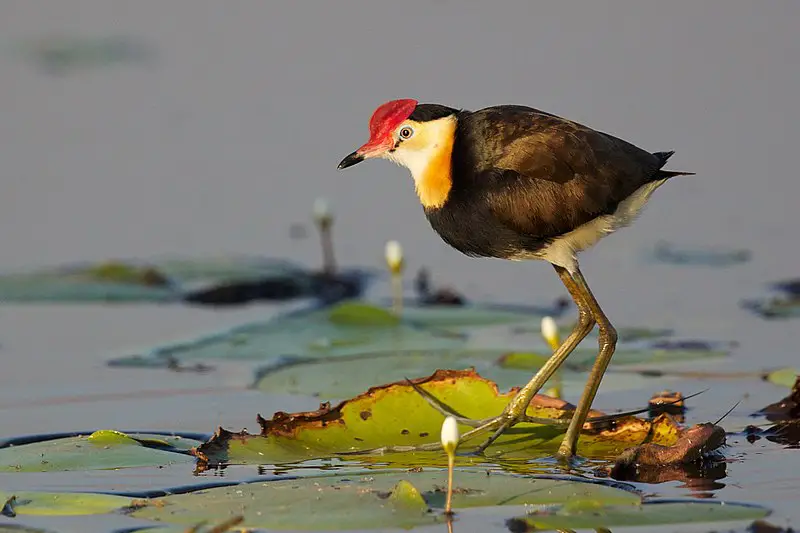
Jacanas are tropical waders belonging to the Jacanidae family. They have distinctive elongated toes and toenails which help them forage on floating or semi-emergent aquatic vegetation.
This adaptation gives them their nickname “Jesus birds” as they seem to be able to walk on water.
The female jacanas are also unique amongst bird species in that they take charge of nest building, incubation and caring for young while males perform courtship displays.
These unusual birds can be found throughout the world’s tropical regions where they inhabit wetlands such as swamps, marshes and shallow lakes with lily pads.
With a wide variety range due their special adaptations these beautiful creatures will surely continue living life at ease around our planet’s warmest waters.
Scientific classification:
| Kingdom | Animalia |
| Phylum | Chordata |
| Class | Aves |
| Order | Charadriiformes |
| Suborder | Thinocori |
| Family | Jacanidae Stejneger, 1885 |
Also Featured In: Birds that You’ll Find in Puerto Rico, Birds that Charles Darwin Studied
27. Plovers

Plovers are a family of around 64-68 species of ground-dwelling birds, commonly found in open country such as fields, meadows and tundras.
They have short bills with webbed feet to help them forage through mud or shallow water.
Plover plumage is usually mottled brown though some species may have brighter colors on the head and wings.
These birds feed mainly on insects but can also eat small crustaceans and worms.
Plovers breed during springtime when they dig holes in sandy or pebbled beaches to lay their eggs which hatch after about 3 weeks incubation period.
They use distraction display behaviour by pretending an injury to the predators away from their nests if needed for protecting their young ones.
Scientific classification:
| Kingdom | Animalia |
| Phylum | Chordata |
| Class | Aves |
| Order | Charadriiformes |
| Family | Charadriidae Leach, 1820 |
28. Araripe Manakin
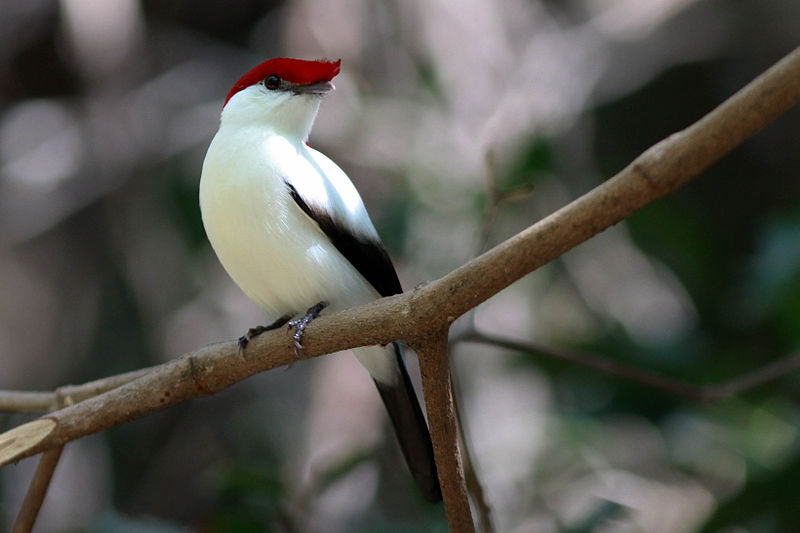
The Araripe Manakin is a small, critically endangered bird with a helmet-like crown. It was discovered in 1996 in the Brazilian state of Ceará and scientifically described two years later.
The species epithet honors Werner Bokermann, an influential zoologist and wildlife filmmaker who died in 1995.
In Portuguese it has been given the name soldadinho-do-araripe due to this unique feature which makes it easily recognizable among other manakins.
Its population size is unknown but believed to be very low as its range includes only one known location where suitable habitat remains for its survival.
Scientific classification:
| Kingdom | Animalia |
| Phylum | Chordata |
| Class | Aves |
| Order | Passeriformes |
| Family | Pipridae |
| Genus | Antilophia |
| Species | A. bokermanni |
29. Violet-Capped Woodnymph
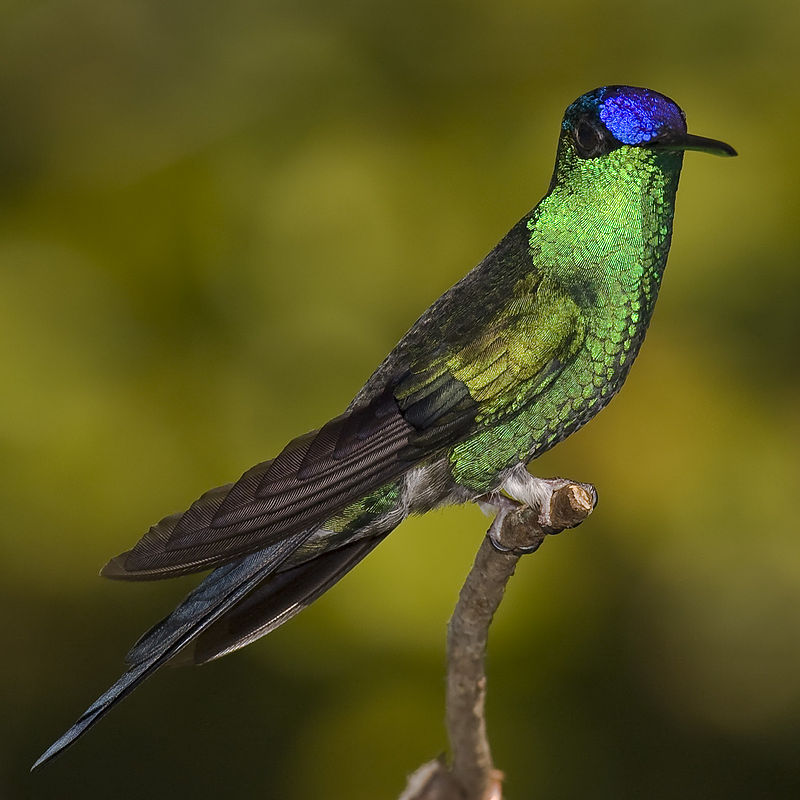
The Violet-capped Woodnymph is a species of hummingbird found in Argentina, Brazil, Paraguay and Uruguay. They are members of the Trochilini tribe within the Subfamily Trochilinae – commonly referred to as “emeralds”.
It was formally described by German naturalist Johann Friedrich Gmelin in 1788, who placed it with other long-tailed hummingbirds in his revised edition of Carl Linnaeus’ Systema Naturae.
This small bird has an unmistakable appearance: its head and back are iridescent green while its throat and belly have yellowish undertones.
Its most striking feature is the violet cap on top of its head which gives this bird its name. The males also sport two white spots at their shoulder blades that can be seen when they fly.
With wingspan reaching up to 8cm (3inches), these birds feed primarily on nectar from flowers or insects such as mosquitoes and moths for protein intake.
Scientific classification:
| Kingdom | Animalia |
| Phylum | Chordata |
| Class | Aves |
| Order | Apodiformes |
| Family | Trochilidae |
| Genus | Thalurania |
| Species | T. glaucopis |
30. Northern Storm Petrels
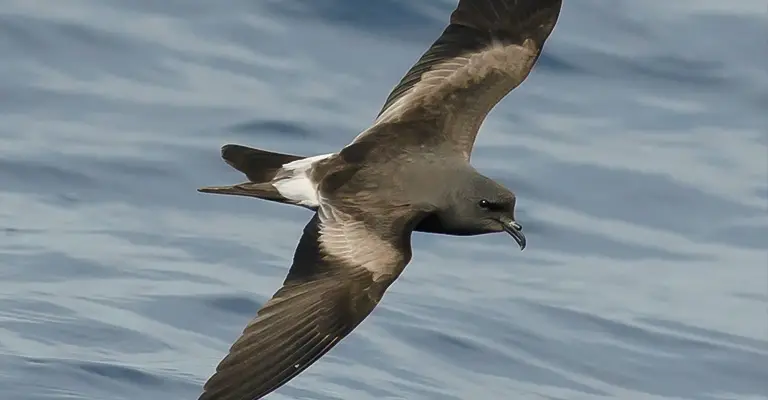
Northern storm petrels are one of the smallest seabirds, inhabiting oceans all over the world.
They have a unique ability to hover over water and pick planktonic crustaceans and small fish from the surface.
Northern storm petrels belong to the genus Hydrobates in family Hydrobatidae, part of Procellariiformes order.
This species was once lumped with austral storm petrel but recent studies show that they weren’t related closely which led them being split into two distinct species now.
These birds can be identified by their dark grey upperparts and wings along with white underparts when seen from afar while feeding on ocean’s surface.
Scientific classification:
| Kingdom | Animalia |
| Phylum | Chordata |
| Class | Aves |
| Order | Procellariiformes |
| Family | Hydrobatidae Mathews, 1912 |
| Genus | Hydrobates F. Boie, 1822 |
Also Featured In: Birds of Sweden, Lebanon Birds Live in Semi-Desert Areas
31. Scarlet Ibis
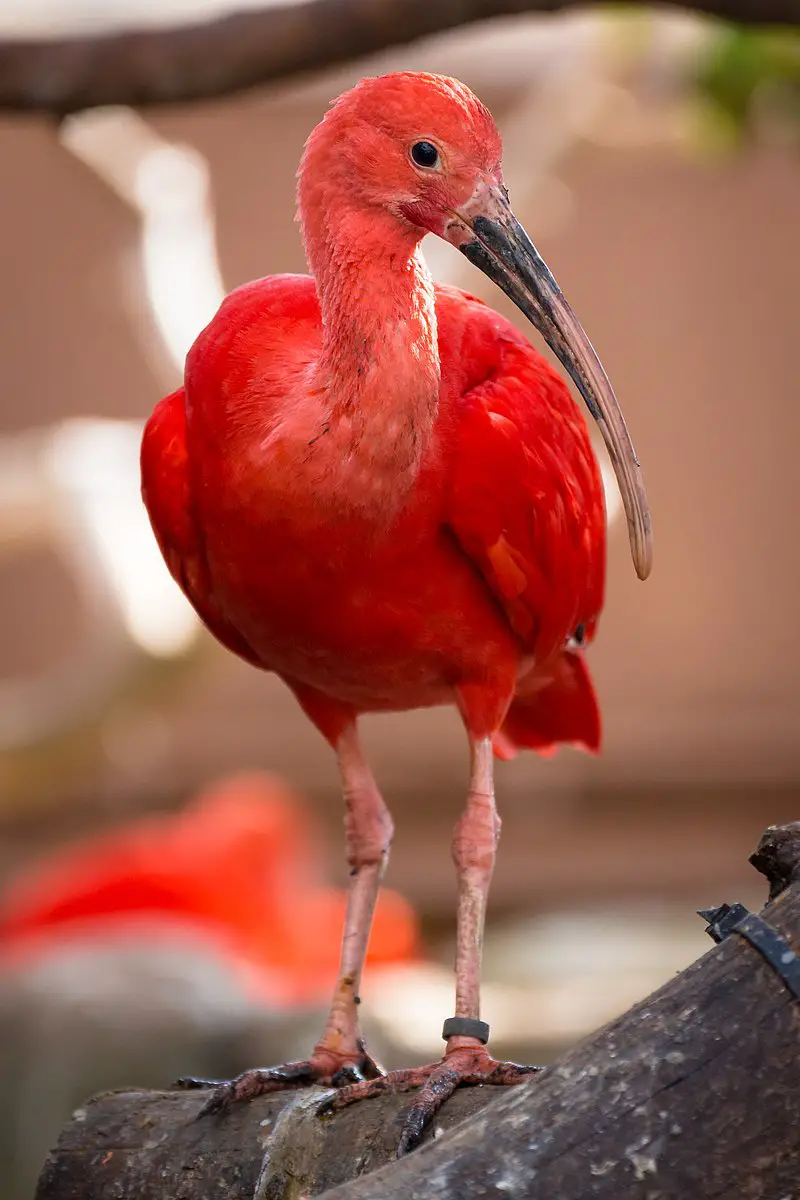
The Scarlet Ibis is a stunning bird, native to tropical South America and the Caribbean. With its distinctive scarlet coloration, it stands out from other ibises in the Threskiornithidae family.
It has become one of two national birds of Trinidad and Tobago with a Tupi-Guarani name: guará.
This species can grow up to 28 inches long with an impressive wingspan of 39–41 inches wide.
The striking red feathers are found mainly on their body while wings, head and neck range from white or greyish colors.
They have black legs with pink webbed feet that help them thrive as they wade through shallow water searching for food such as shrimp, crabs and small fish – all essential components to their diet.
Despite its beauty, this species faces threats due increasing habitat destruction caused by deforestation practices in areas where it lives making conservation efforts crucial for protecting these majestic creatures before they disappear forever.
Scientific classification:
| Kingdom | Animalia |
| Phylum | Chordata |
| Class | Aves |
| Order | Pelecaniformes |
| Family | Threskiornithidae |
| Genus | Eudocimus |
| Species | E. ruber |
32. Blue-And-Yellow Macaw
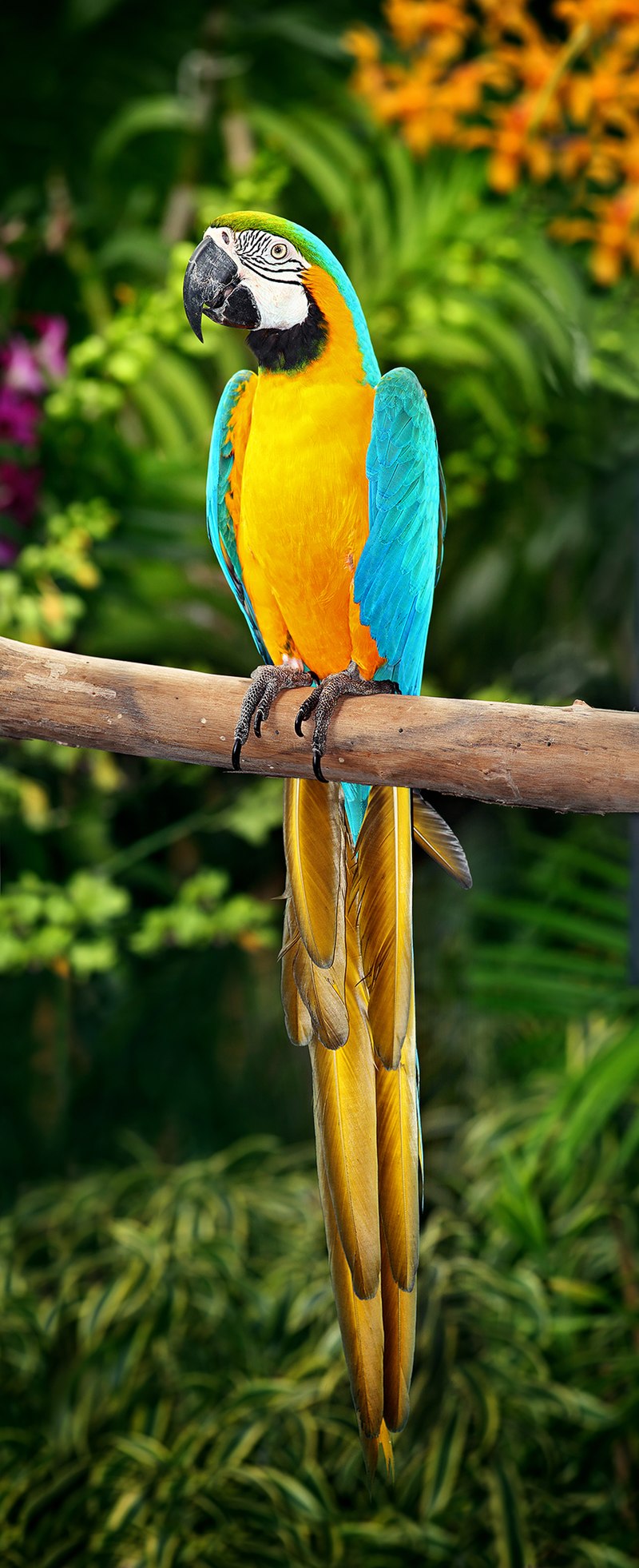
The Blue-and-yellow Macaw is a vibrant and eye catching bird native to South America. It has beautiful blue top parts, light orange underparts, and green on its head.
This large parrot lives in the tropical forests of varzea, terra firme or unflooded forest areas.
They are social birds that live in small flocks which can range from two to twenty birds during breeding season when they look for mates.
They feed mainly on seeds, nuts and fruits but sometimes also eat insects like beetles and caterpillars as well as tender shoots from trees & plants.
These macaws have an impressive call with loud screams used both to attract mates and communicate between members of their flock while flying long distances across open fields together.
Scientific classification:
| Kingdom | Animalia |
| Phylum | Chordata |
| Class | Aves |
| Order | Psittaciformes |
| Family | Psittacidae |
| Genus | Ara |
| Species | A. ararauna |
Also Featured In: Case Birds that Live in with Us, Pet Birds that Live in India
33. Tropicbirds
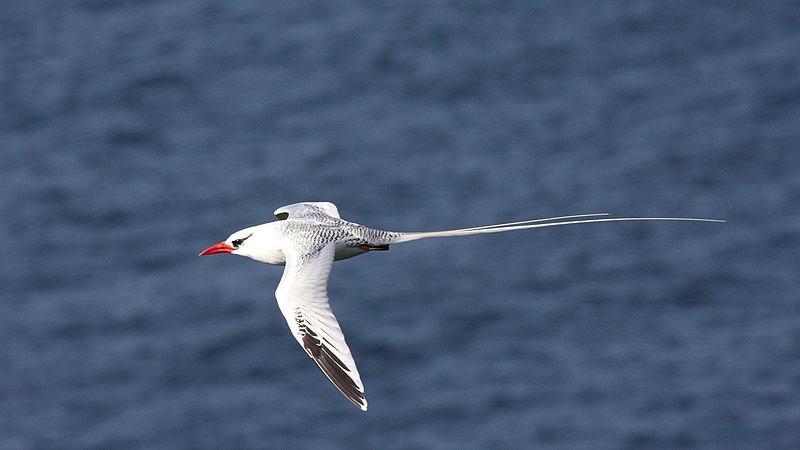
Tropicbirds are a unique family of birds, belonging to the order Phaethontiformes. They have long, white tail feathers and bright-colored beaks.
These features make them easily recognizable from other bird species.
Tropicbirds live in tropical seas throughout the world where they feed on fish and squid near coral reefs or ocean surface waters.
They breed mainly on remote islands with few predators, nesting their eggs in crevices or burrows dug into sandy soil by both parents for about five weeks until hatching takes place.
When not breeding tropicbirds can travel up to 10 000 km over several months before returning home again.
Their beauty is remarkable – so if you ever get a chance to see one of these magnificent birds flying gracefully above the sea then take it as an opportunity not to be missed.
Scientific classification:
| Kingdom | Animalia |
| Phylum | Chordata |
| Class | Aves |
| Clade | Eurypygimorphae |
| Order | Phaethontiformes Sharpe, 1891 |
34. Stone-Curlew

Stone-curlews, also known as dikkops or thick-knees, are a family of birds that have adapted to live in tropical and temperate regions throughout the world.
They can be found in Africa, Asia and Australia with two or more species per region. Despite being classified as waders, most prefer dry arid habitats over moist wetlands.
Stone-curlews typically have long legs which help them navigate through their preferred terrain efficiently; some species even stand at an impressive height when standing on those long legs.
Additionally they feature cryptic plumage which helps them blend into their surroundings while hunting for prey such as insects and small mammals like rodents.
These unique bird’s calls are easily recognizable; it has been said that hearing one is similar to listening to someone whistling ‘Keee Weee’.
Scientific classification:
| Kingdom | Animalia |
| Phylum | Chordata |
| Class | Aves |
| Order | Charadriiformes |
| Suborder | Chionidi |
| Family | Burhinidae Mathews, 1912 |
Also Featured In: Common Uzbekistan Birds, Most Common Romanian Birds
35. Painted-Snipe
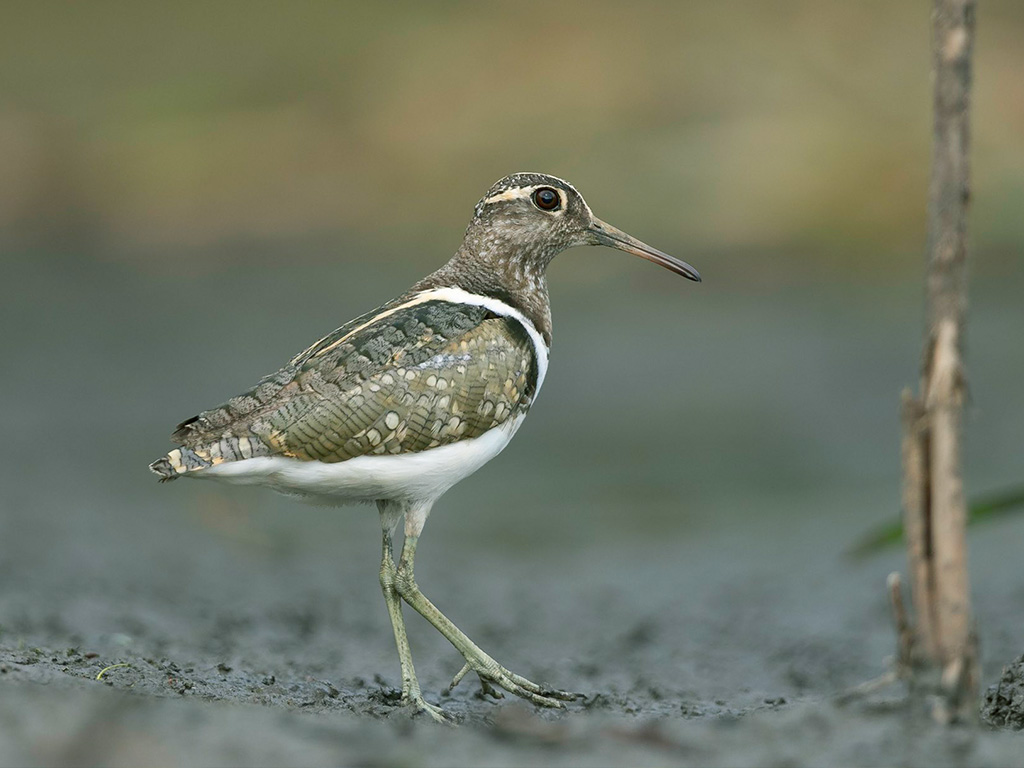
Painted snipes are beautiful and unique wading birds found in the Rostratulidae family. They have short legs, long bills, and a striking plumage which distinguishes them from true snipes.
Males tend to be smaller than females with duller overall coloration. There are three species of painted snipe.
The Greater Painted Snipe, Lesser Painted Snipe, and Australian Painted Snipe – all three have different habitats ranging from wetland pools to grasslands or mangroves depending on their region.
These birds feed mainly on earthworms but also consume insects, crustaceans and plant material when available.
As they rely heavily on wetlands for breeding purposes it is important that we protect these precious habitats so that this special bird can continue to thrive.
Scientific classification:
| Kingdom | Animalia |
| Phylum | Chordata |
| Class | Aves |
| Order | Charadriiformes |
| Suborder | Thinocori |
| Family | Rostratulidae Coues, 1888 |
36. Caprimulgiformes
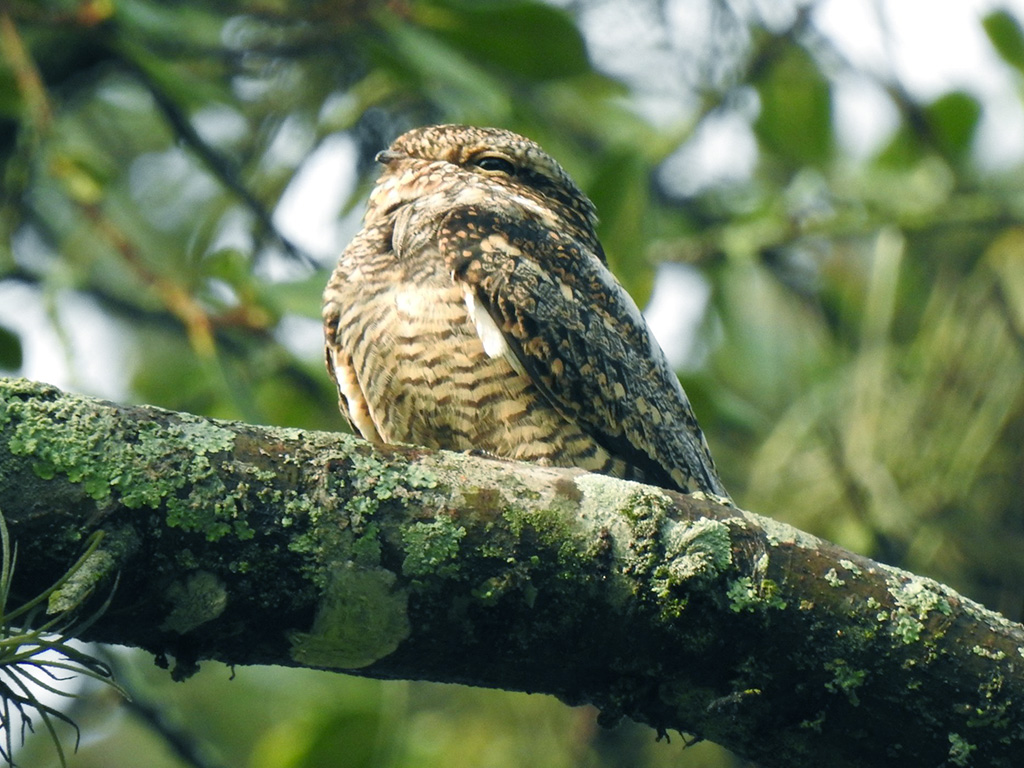
Cuculiformes are a large order of birds that includes cuckoos, roadrunners and turacos. These birds have long wings, short tails and strong legs which help them to fly from tree-to-tree in search for food.
They also use their feet to grab items such as insects or fruits while hopping around branches. Cuculiformes feed on invertebrates like caterpillars , spiders, moths & lizards but some species will eat fruit & seeds too .
Their nests usually consist of twigs lined with soft material such as feathers or moss depending on the specie they belong to. The eggs laid by cucilforme females range between white to yellowish brown colouration speckled with reddish spots.
Most Cucilformes exhibit monogamous behaviour where both parents participate in taking care of the young ones until they can fly away independently
37. Heliornithidae
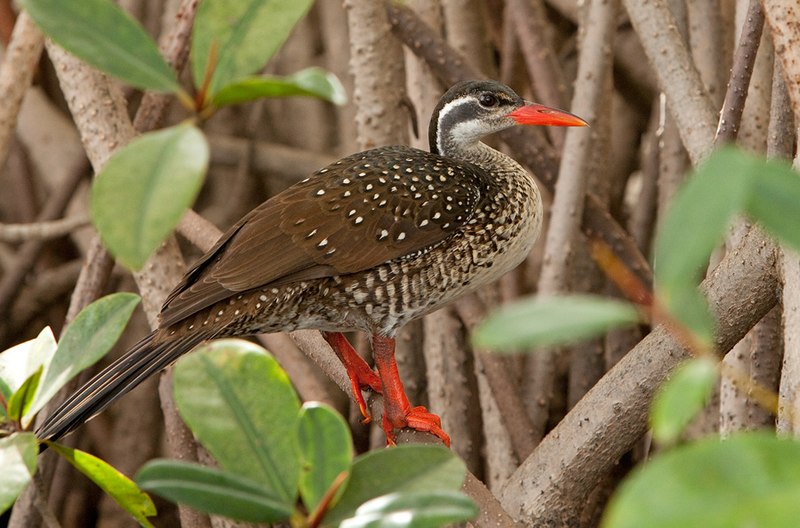
Heliornithidae, commonly known as finfoots, are a small family of tropical birds found in South America and Africa. They have webbed feet like grebes or coots, long necks, slender bodies and broad tails with sharp pointed bills.
Their diverse calls include whistles, squawks and croaks which they use to communicate with each other.
Finfoots feed mainly on fish but also consume insects such as water beetles and dragonflies near the surface of waterbodies.
They nest around rivers or lakes where there is plenty of cover from predators such as eagles or hawks.
During breeding season males can become quite territorial defending their territories against intruders by chasing them off aggressively using loud noises or even physical contact if necessary.
Scientific classification:
| Kingdom | Animalia |
| Phylum | Chordata |
| Class | Aves |
| Order | Gruiformes |
| Family | Heliornithidae GR Gray, 1840 |
Also Featured In: Birds of Côte d’Ivoire, Birds that Found in Sumatra
38. Seedsnipe
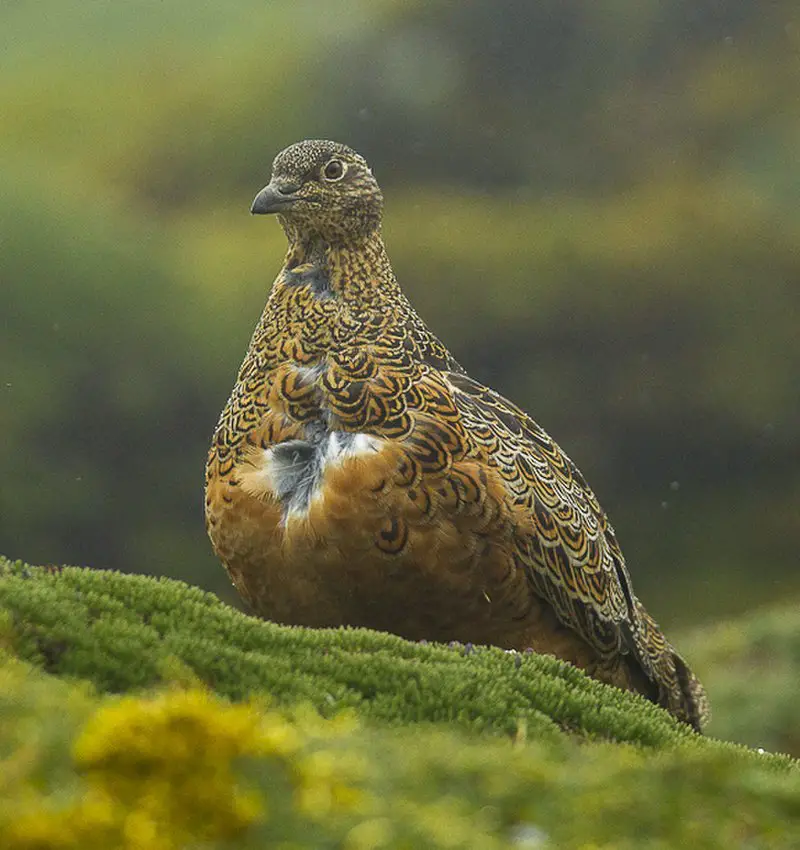
Seedsnipes are small wading birds from South America, mainly found in Andean and Patagonian regions. They form two genera – Attagis and Thinocorus – each containing two species.
Seedsnipes live in flocks and have adapted to a herbivorous diet. Although their exact relationship with other families of the Charadriiformes order is unknown, it has been suggested that they may be related to plovers or sandpipers.
These tiny birds feed on vegetation such as grass seeds, buds, shoots and leaves which they find among rocks or sparsely vegetated areas at high altitudes. Their brown-and-white plumage blend perfectly into their environment making them difficult to spot while feeding.
Scientific classification:
| Kingdom | Animalia |
| Phylum | Chordata |
| Class | Aves |
| Order | Charadriiformes |
| Suborder | Thinocori |
| Family | Thinocoridae Gray, 1845 |
39. New World Quail
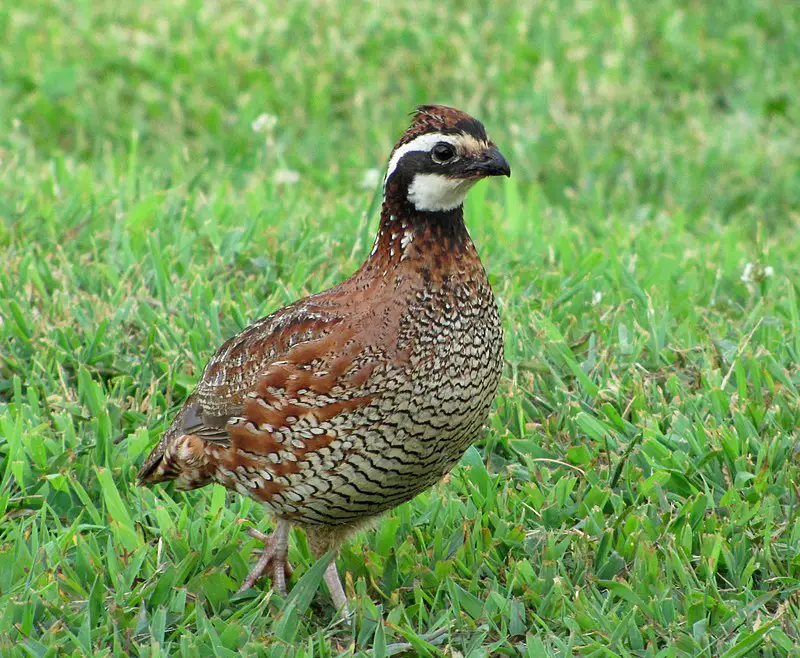
New World quail are small birds found in the Americas, from Canada to Brazil. They belong to their own family, Odontophoridae, and have similar appearance and habits as Old World quail which belong to a different family.
New World Quails come in various species such as California Quail and Bobwhite Quail.
These birds have adapted well to human presence due to availability of food resources like agricultural crops.
They also live close together where they form large flocks for safety against predators like foxes or hawks.
The males usually sport colorful feathers during mating season that helps them attract female mates while providing an amazing sight for us viewers.
Scientific classification:
| Kingdom | Animalia |
| Phylum | Chordata |
| Class | Aves |
| Order | Galliformes |
| Superfamily | Phasianoidea |
| Family | Odontophoridae Gould, 1844 |
40. Potoo
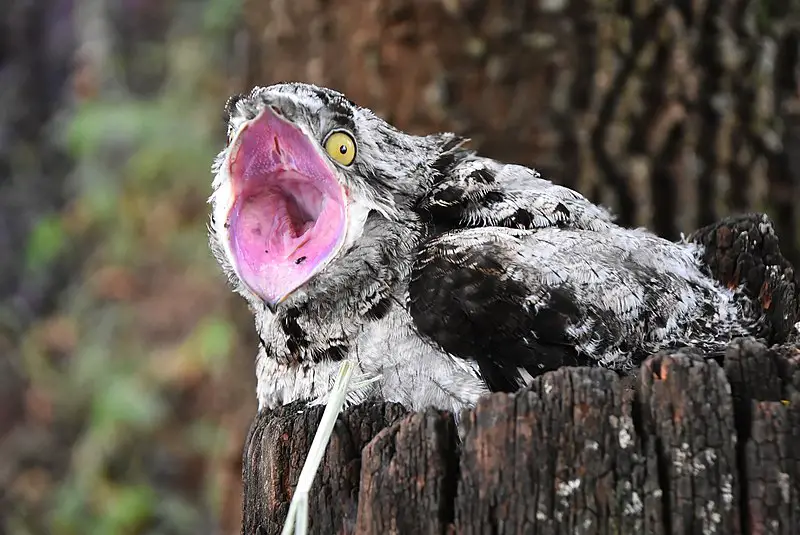
Potoo birds, or Nyctibius, are nocturnal creatures in the family of Nyctibiidae. They have a distinct long beak and large eyes that help them find prey during night time hunting.
These interesting-looking birds build their nests on tree branches near water sources such as rivers and lakes for easy access to food.
Potoos also use camouflage to blend into their surroundings when sleeping during the day; this helps protect them from predators like hawks who can spot an easily visible bird from miles away.
Potoos live in tropical regions throughout Central America and South America where they hunt small insects at night with their sharp sense of hearing allowing them to quickly locate hidden prey even in darkness.
Scientific classification:
| Kingdom | Animalia |
| Phylum | Chordata |
| Class | Aves |
| Order | Nyctibiiformes |
| Family | Nyctibiidae |
| Subfamily | Nyctibiinae |
| Genus | Nyctibius Vieillot, 1816 |
Also Featured In: Birds You’ll Find in Night,
41. Psophia
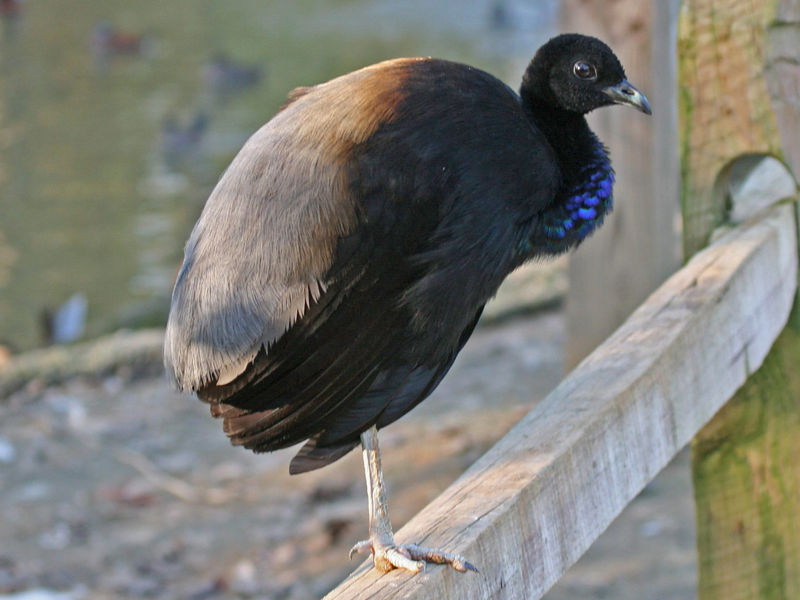
Psophia is a genus of birds found in South America, and are the only members of the Psophiidae family. They have an unmistakable appearance, with their long legs and necks giving them a chicken-like stature.
Males make loud trumpeting or cackling noises when they feel threatened. The three species range from 45 to 52 centimetres (18 to 20 inches) in length, weighing up to 1.5 kg (2 lbs).
They live mainly in humid forests across the Amazon and Guiana Shield regions, where there is plenty for them forage on such as fruit, insects and small animals like lizards or frogs.
These fascinating creatures play an important role within their environment; helping disperse seeds throughout the forest by eating fruits which contain large quantities of seeds that will eventually be spread elsewhere through defecation.
Scientific classification:
| Kingdom | Animalia |
| Phylum | Chordata |
| Class | Aves |
| Order | Gruiformes |
| Family | Psophiidae Bonaparte, 1831 |
| Genus | Psophia Linnaeus, 1758 |
42. Glareolidae
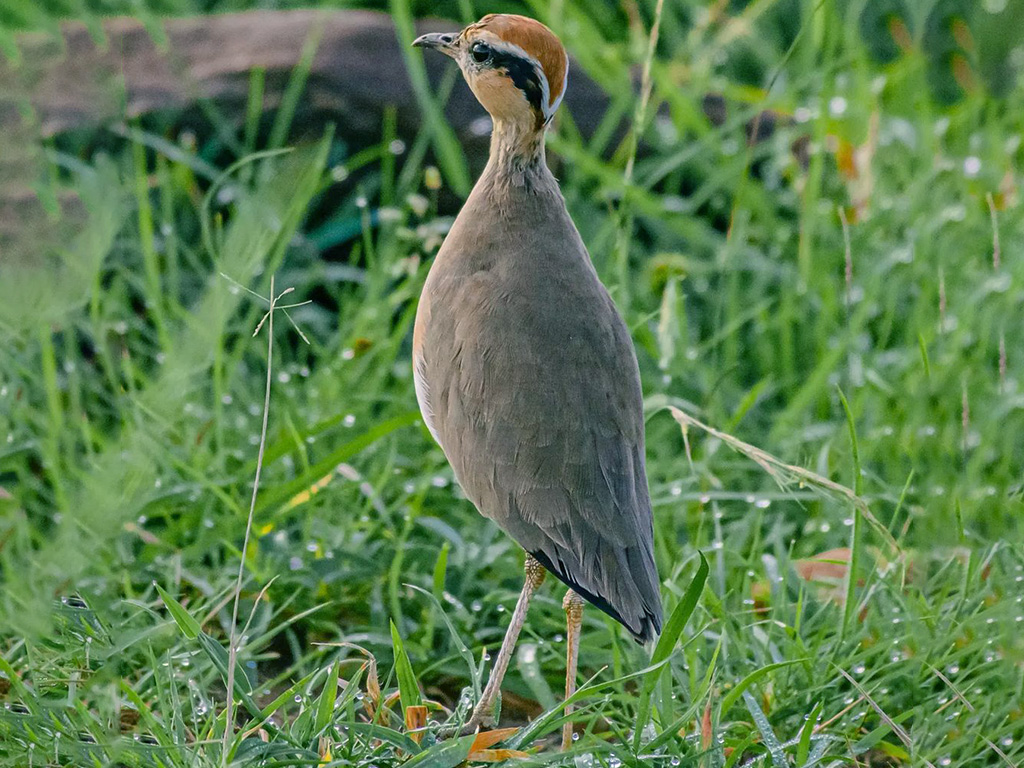
Glareolidae is a family of wading birds, consisting of four genera and 17 species. They are distinguished from other charadrii by their long bills which have a slight downward curve.
Glareolidae live around open grasslands and deserts, where they hunt for insects using the bill to probe into soil or vegetation.
Most species are found in Africa but two pratincoles inhabit parts of Europe and Asia as well.
Coursers tend to be larger than pratincoles with longer legs allowing them to run quickly across sandy dunes while feeding on small animals like lizards or spiders.
Pratincoles feed mainly on flying insects, snatching them out of midair with great agility during flight.
All glareolids share unique features such as large eyes that help it spot prey at night easily making this group one interesting bird family.
Scientific classification:
| Kingdom | Animalia |
| Phylum | Chordata |
| Class | Aves |
| Order | Charadriiformes |
| Suborder | Lari |
| Family | Glareolidae CL Brehm, 1831 |
43. American Golden Plover
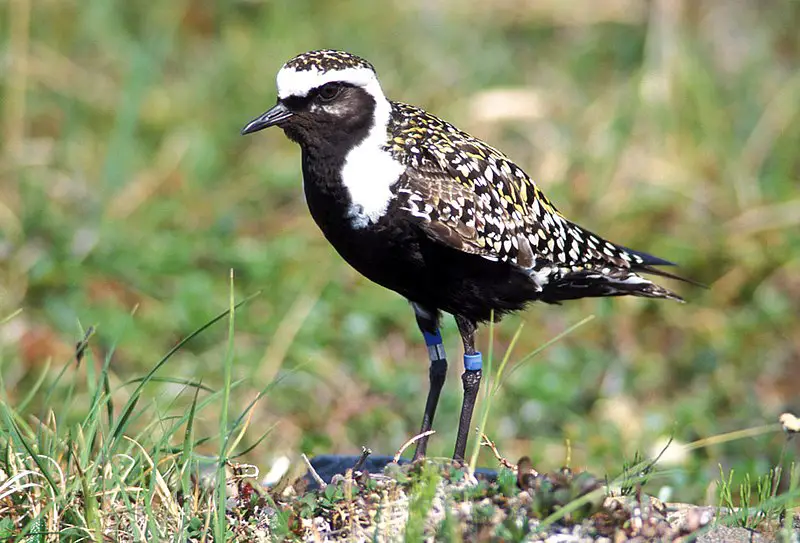
The American golden plover (Pluvialis dominica) is a medium-sized bird, part of the genus Pluvialis which translates to “relating to rain”.
It was named after Santo Domingo in the West Indies and believed that when they flocked, it predicted an upcoming rainfall.
Their nests are lined with spores picked up from their habitat – this also helps protect eggs against predators or parasites.
The birds have distinctive yellow and black plumage, allowing them to stand out amongst other species and making them easier for predators to spot.
They can fly great distances during migration season and inhabit open grasslands as well as arctic tundra regions all over North America throughout different times of year.
Scientific classification:
| Kingdom | Animalia |
| Phylum | Chordata |
| Class | Aves |
| Order | Charadriiformes |
| Family | Charadriidae |
| Genus | Pluvialis |
| Species | P. dominica |
44. Collared Pratincole
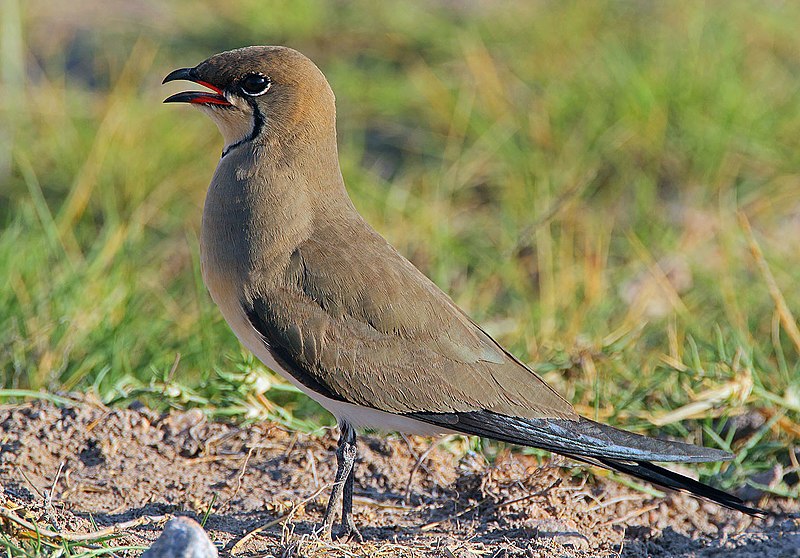
The Collared Pratincole is a small wader bird native to the Old World. It has distinctive long wings that are reddish-brown in color and have white tips, which give it its name.
Its body is mostly dark brown with some lighter spots along its back and sides. The bill of this species is short and pointed, making it a specialist for eating insects from mudflats or shallow waters.
During breeding season, they form loud flocks that can be heard from miles away when calling out their distinct song; during non-breeding time they disperse into smaller groups while searching for food sources in drier regions such as grasslands or fields.
This species relies heavily on open habitats where there are plenty of places to hunt for food throughout the year.
Scientific classification:
| Kingdom | Animalia |
| Phylum | Chordata |
| Class | Aves |
| Order | Charadriiformes |
| Family | Glareolidae |
| Genus | Glareola |
| Species | G. pratincola |
Also Featured In: Birds That Live in Iraq, Birds Live in Tunisia
45. Ciconiiformes
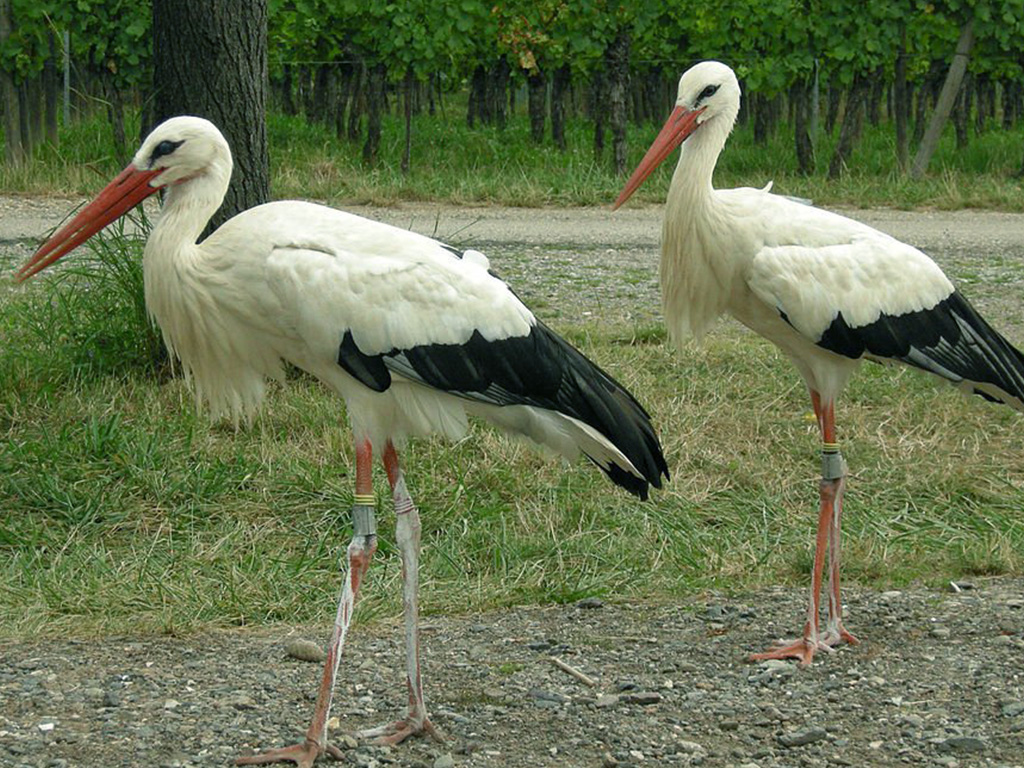
Cuculiformes are a large order of birds that includes cuckoos, roadrunners and turacos. These birds have long wings, short tails and strong legs which help them to fly from tree-to-tree in search for food.
They also use their feet to grab items such as insects or fruits while hopping around branches. Cuculiformes feed on invertebrates like caterpillars , spiders, moths & lizards but some species will eat fruit & seeds too .
Their nests usually consist of twigs lined with soft material such as feathers or moss depending on the specie they belong to. The eggs laid by cucilforme females range between white to yellowish brown colouration speckled with reddish spots.
Most Cucilformes exhibit monogamous behaviour where both parents participate in taking care of the young ones until they can fly away independently
46. Great Skua
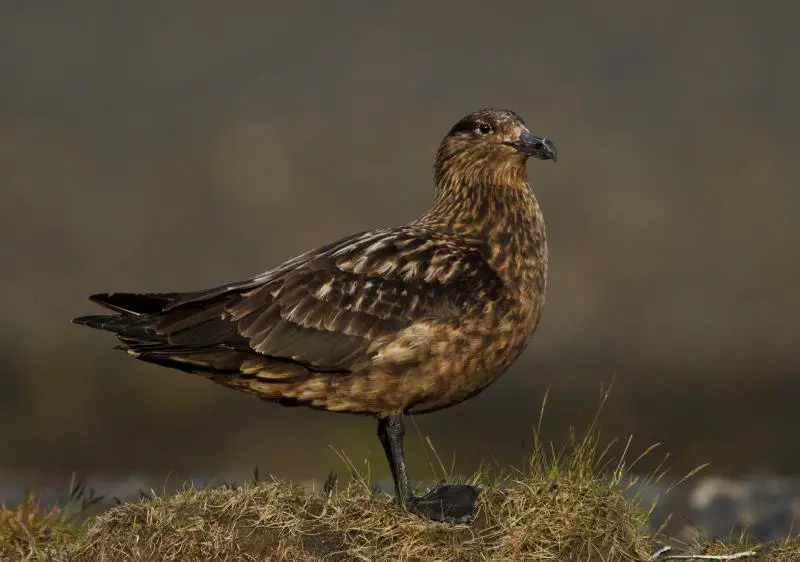
The Great Skua is a large sea bird belonging to the family Stercorariidae, found in areas such as Faroe Islands and Iceland.
It has a size similar to that of herring gulls, with its diet consisting mainly of fish caught at the surface or taken from other birds.
This species was first described by Danish zoologist Morten Thrane Brünnich in 1764 under the name Cath.
They are powerful predators who will sometimes use mobbing tactics against larger prey like gannets and eiders until they give up their catch.
These birds mate for life but may build nests near colonies if there aren’t enough suitable territories available on their own island range.
Although these skuas might seem intimidating due to their fierce nature when protecting young, they can be quite timid around humans so should not be approached too closely.
Scientific classification:
| Kingdom | Animalia |
| Phylum | Chordata |
| Class | Aves |
| Order | Charadriiformes |
| Family | Stercorariidae |
| Genus | Stercorarius |
| Species | S. skua |
Also Featured In: Most Common Scotland Birds, Shetland Islands Birds You Should Know
47. Rheas
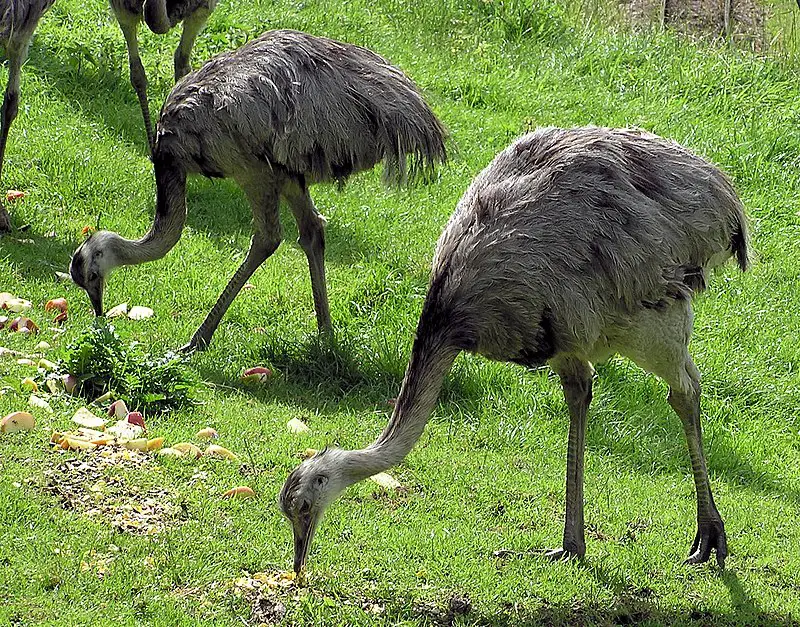
Rheas are large flightless birds native to South America, related to the ostrich and emu. There are two extant species: The Greater or American Rhea (Rhea americana) and the lesser or Darwin’s Rhea (Pterocnemia pennata).
They have long legs, strong feet with three toes that help them run swiftly on land; they can also swim well.
Their wings may be small but they’re used for balance during running. These birds usually weigh between 30-60 pounds depending on the species, with a length of up to 6 ft.
Both male and female rheas display plumage in shades of greyish browns which blend into their surroundings – perfect camouflage.
Scientific classification:
| Kingdom | Animalia |
| Phylum | Chordata |
| Class | Aves |
| Infraclass | Palaeognathae |
| Order | Rheiformes |
| Family | Rheidae |
| Genus | Rhea Brisson, 1760 |
48. Black-Necked Stilt
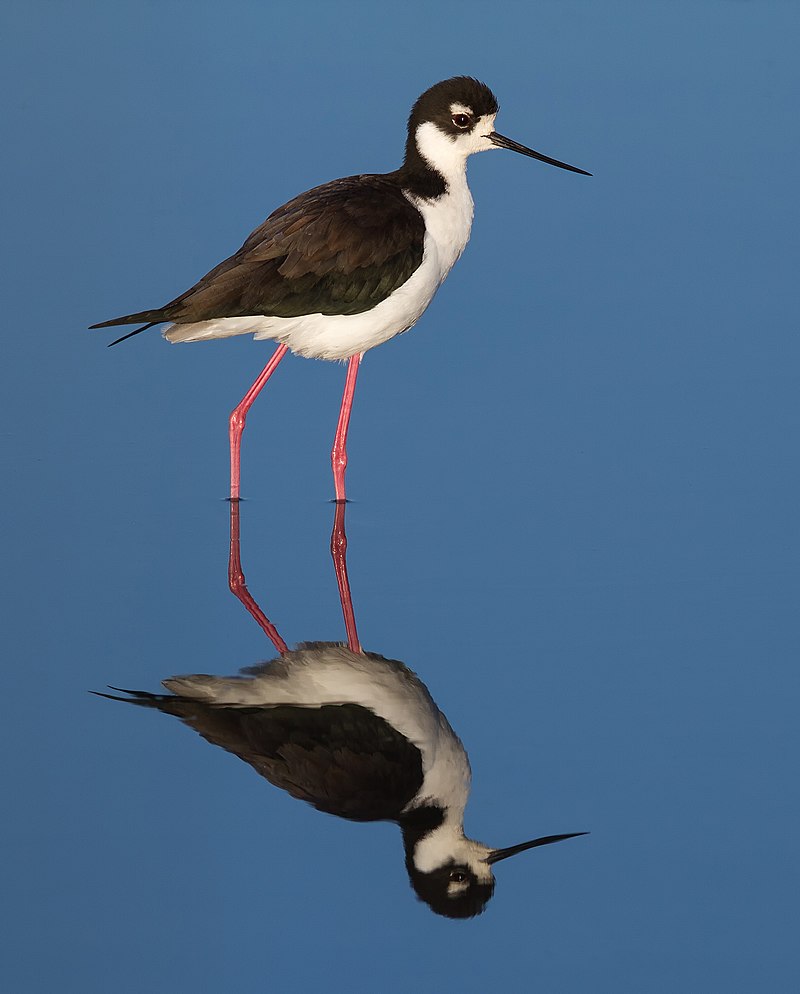
The Black-necked Stilt is an elegant shorebird that can be found from the coastal areas of California to Florida, then south through Central America and Brazil.
It has black upperparts contrasted by long white wings with a glossy sheen. Its striking red eyes are set against its white facial mask while its legs are bright pinkish in coloration.
The Haematopus mexicanus species inhabits marshy wetlands and brackish lagoons where it feeds on insects, crustaceans, small amphibians and fish which they catch using their slender bill or chase after them as they run across the surface of water or mudflats.
This bird typically nests near shallow waters but will use any habitat type if food resources are available nearby making it a highly adaptable species well suited for human altered habitats such as rice fields and sewage ponds.
Scientific classification:
| Kingdom | Animalia |
| Phylum | Chordata |
| Class | Aves |
| Order | Charadriiformes |
| Family | Recurvirostridae |
| Genus | Himantopus |
| Species | H. mexicanus |
Also Featured In: Phoenix Birds You Should Know, Most Common Oahu Birds
49. Guans
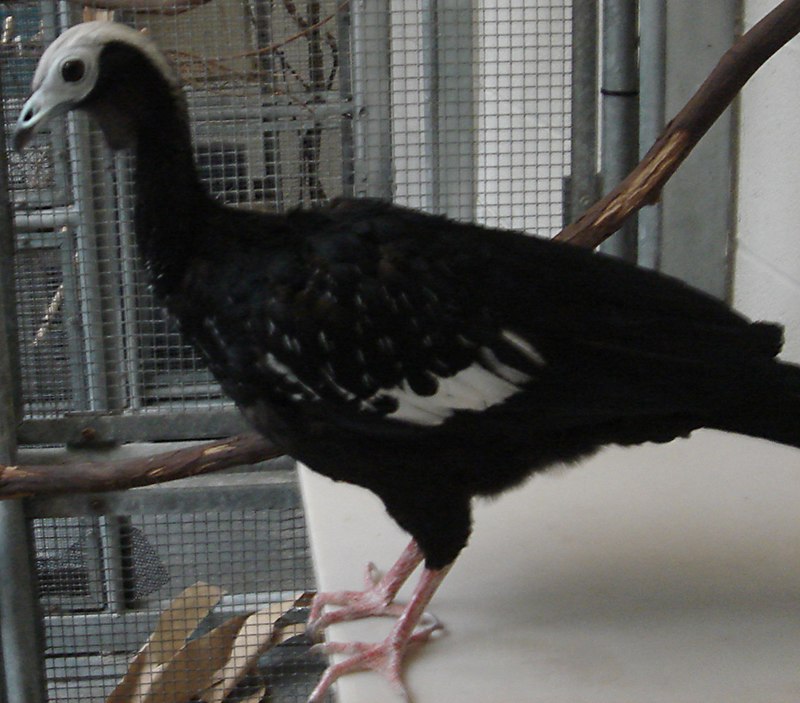
Guan is a genus of bird that belongs to the family Cracidae. These remarkable birds are mostly found in South America, Central America and some Caribbean islands.
The most peculiar species among them is the Horned Guan (Oreophasis derbianus), an ancient cracid with no close living relatives.
Guans have adapted well to their environment over time as they live in habitats ranging from tropical rainforest to high-altitude cloud forests and dry woodland scrublands.
They usually feed on fruits, flowers, leaves and insects which gives them their distinctive vibrant colours. With many conservation efforts taking place across various parts of its range, these beautiful creatures will hopefully keep thriving for generations to come.
Scientific classification:
| Kingdom | Animalia |
| Phylum | Chordata |
| Class | Aves |
| Order | Galliformes |
| Family | Cracidae |
| Subfamily | Penelopinae Huxley, 1868 |
50. Maguari Stork
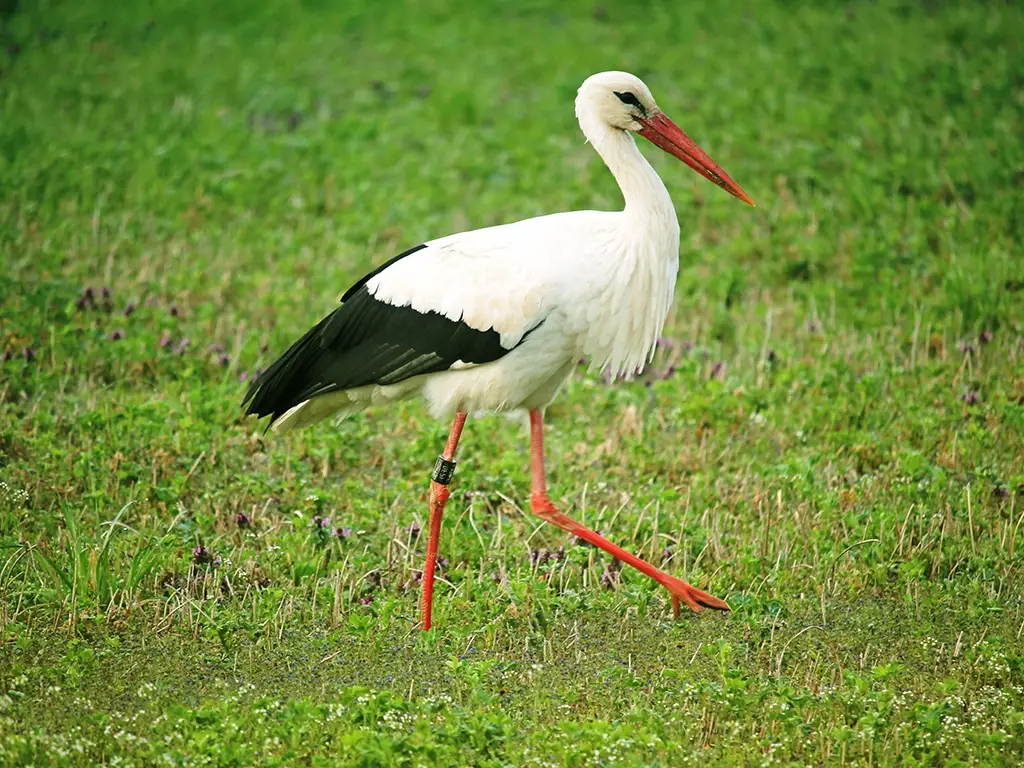
The Maguari stork is a large species of stork found in South America. It has similar features to the white stork, but it is slightly larger.
This bird can be identified by its black body with white patches on its wings and tail feathers and yellow legs which contrast against its dark feathers.
The maguari feeds mainly on fish, amphibians, reptiles, crustaceans and insects; they will also scavenge for food when necessary.
These birds breed during wetland seasons where their nests are made up of sticks or reeds built high above the ground in trees near water bodies such as rivers or swamps.
Their populations have been decreasing due to habitat loss from human activities such as agricultural expansion or deforestation however conservation efforts are being put into place to help protect this unique species so that we may continue enjoy watching these magnificent birds soar through our skies.
Scientific classification:
| Kingdom | Animalia |
| Phylum | Chordata |
| Class | Aves |
| Order | Ciconiiformes |
| Family | Ciconiidae |
| Genus | Ciconia |
| Species | C. maguari |
51. White-Bellied Storm Petrel
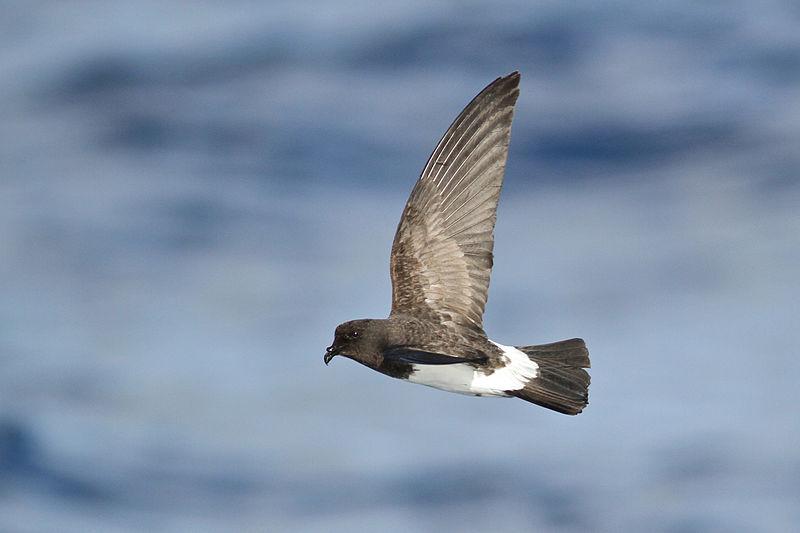
The White-bellied Storm Petrel is a small seabird that can be found in many different places around the world such as Angola, Argentina, Australia, Brazil and more.
Its natural habitat consists of open seas. It was formally described by French ornithologist Louis Jean Pierre Vieillot back in 1818.
This species has black upperparts with white underparts including its breast and belly which gives it an overall greyish appearance when seen from afar.
They are mostly observed flying low over the sea surface or hovering above waves foraging for food during low tide periods; their diet mainly consisting of crustaceans like squid and shrimp along with fish larvae too.
Scientific classification:
| Kingdom | Animalia |
| Phylum | Chordata |
| Class | Aves |
| Order | Procellariiformes |
| Family | Oceanitidae |
| Genus | Fregetta |
| Species | F. grallaria |
Also Featured In: Birds That Live In Tristan da Cunha, Gough Island Birds You Should Know